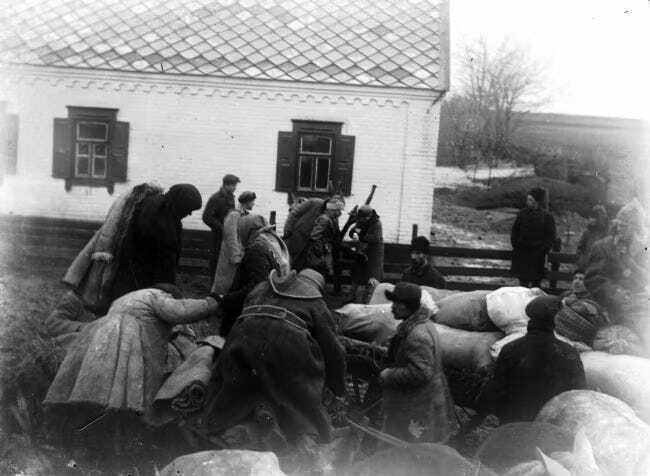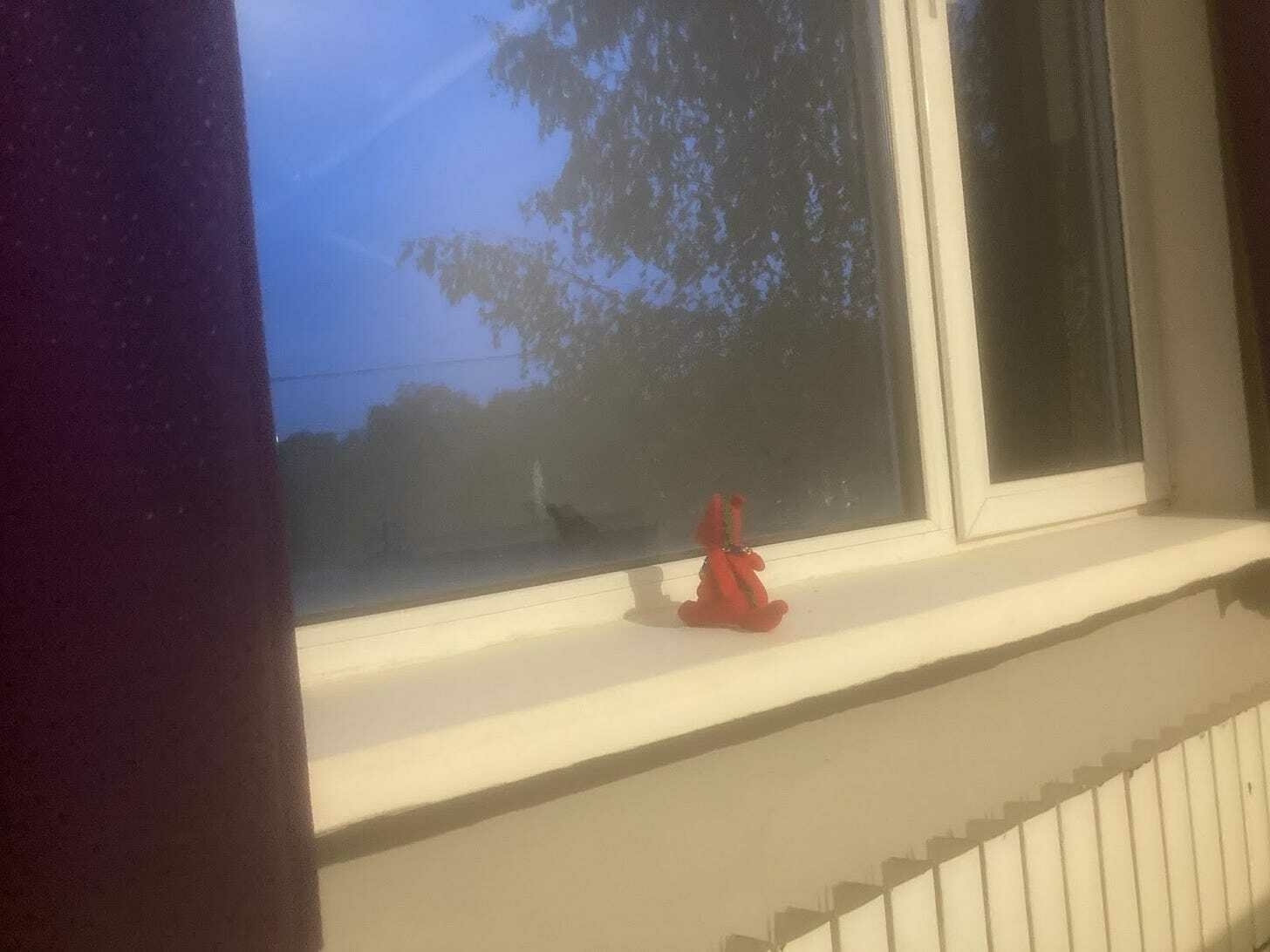-
Ukraine war latest: Ukraine strikes targets in Russia, including gunpowder plant
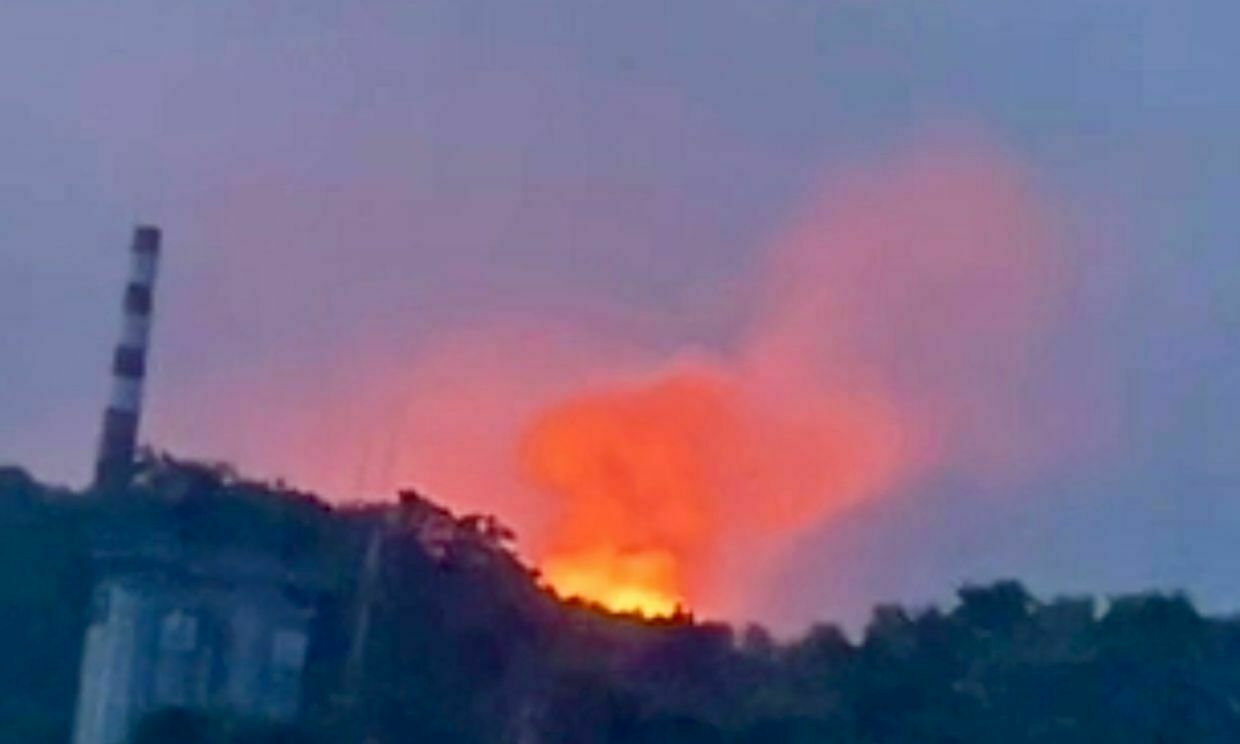
Key developments on June 11:
- Ukrainian drones strike targets in Russia, including gunpowder plant, General Staff says
- Zelensky urges ‘stronger’ EU sanctions on Russia, lower oil price cap
- Ukraine repatriates bodies of 1,212 fallen soldiers
- Ukraine’s SBU releases fresh video of Operation Spiderweb, teases ‘new surprises’
- NATO summit statement omits Ukraine’s entry bid, $40 billion pledge, Bloomberg reports
Ukrainian drones struck multiple military targets in Russia, including the Tambov Gunpowder Plant, overnight on June 11, the General Staff of Ukraine’s Armed Forces reported.
The plant, one of Russia’s main manufacturers of gunpowder and explosives for small arms, artillery, and rocket systems, caught fire following the drone strike, according to the General Staff.
Local residents reported hearing explosions and shared videos showing a large blaze near the facility, according to the Russian independent media outlet Astra.
The General Staff described the attack as part of a broader operation to degrade Russia’s ability to produce explosive materials and ammunition used in the full-scale war against Ukraine.
The Tambov facility has been targeted several times since November 2023, and U.S. sanctions were imposed on it that same year. Tambov Oblast, located southeast of Moscow, lies hundreds of kilometers from Ukraine and shares no direct border with it.
Russian state news agency TASS confirmed a drone attack but did not mention the strike on the powder plant. Tambov Oblast Governor Maxim Egorov said that emergency services had extinguished the fire and that there were no casualties, though he did not specify the location of the fire.
In addition to the strike on Tambov, Ukrainian drones hit the ammunition depot of Russia’s 106th Airborne Division in Kursk Oblast and the depot at Buturlinovka airfield in Voronezh Oblast, the General Staff said.
The extent of the damage is still being assessed, the General Staff said.
“The Defense Forces continue to take all measures to undermine the military and economic potential of the Russian occupiers and force Russia to stop its armed aggression against Ukraine,” the statement reads.
Ukraine has ramped up long-range drone strikes in recent weeks, targeting Russian air bases and arms production facilities in an effort to disrupt Moscow’s war machine ahead of an anticipated Russian summer offensive.
As Russia inches closer to Dnipropetrovsk Oblast, new Ukrainian region might soon be at warMoscow said its troops had crossed into Dnipropetrovsk Oblast and were conducting offensive operations in the region, a claim Kyiv quickly denied as “Russian disinformation.” Russian troops have been pushing toward Dnipropetrovsk Oblast for months, trying to solidify the southern flank to capture Pokrovsk and the remaining parts of theThe Kyiv IndependentAsami Terajima
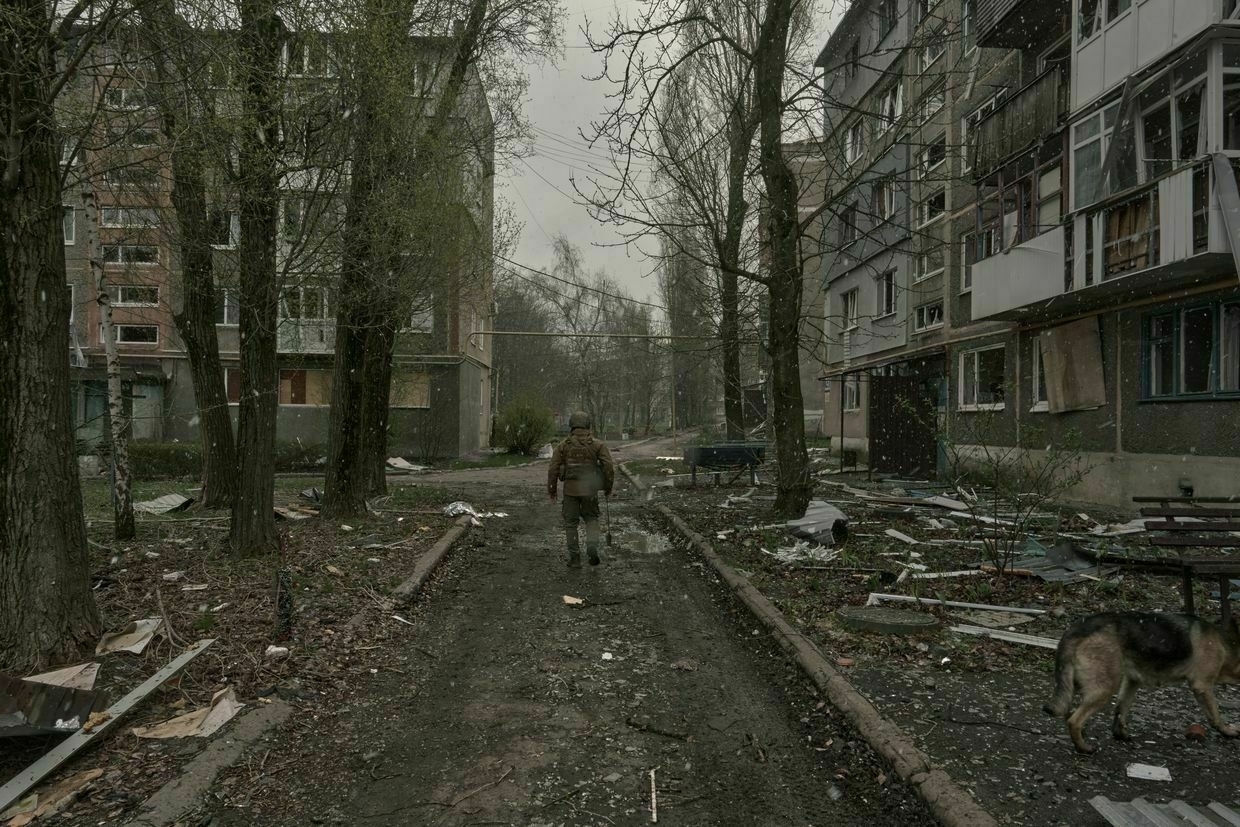
Zelensky urges ‘stronger’ EU sanctions on Russia, lower oil price capPresident Volodymyr Zelensky on June 11 called on the European Union to impose tougher sanctions against Russia, arguing that stronger financial pressure is necessary to curb Moscow’s war effort.
Speaking at the Ukraine-Southeast Europe Summit in Odesa, Zelensky said the upcoming 18th EU sanctions package “could be stronger,” especially in targeting Russian oil tankers and the financial sector. He urged the EU to further reduce the price cap on Russian oil exports.
“A ceiling of $45 per barrel of oil is better than $60, that’s clear, that’s true. But real peace will come with a ceiling of $30,” he said. “That’s the level that will really change the mindset in Moscow."
After the 17th package of sanctions against Russia took effect on May 20, Ukraine’s allies announced the following day that another round of restrictions was already in the works.
European Commission President Ursula von der Leyen announced on June 10 that the EU is considering lowering the oil price cap from $60 to $45 per barrel — a measure that will be discussed at the upcoming G7 summit in Canada on June 15–17.
The Kremlin’s budget is increasingly strained by soaring military expenditures, with Russia’s Finance Ministry relying heavily on energy revenues to fund the war against Ukraine.
The push for tighter sanctions comes as Russia continues to reject ceasefire proposals and presses forward with military operations. Zelensky warned that Odesa remains one of Russia's "main targets," with plans to push beyond it toward the borders with Romania and Moldova.
"Russia wants to destroy it, as it has done with countless cities and villages in the occupied territories," he said. "Russian military plans point to this region — Odesa — and then to the border with Moldova and Romania."
Odesa is a major port city in southern Ukraine, located on the northwestern coast of the Black Sea. The president warned of possible destabilization efforts in the broader region, comparing the Kremlin's strategy to its previous interference in the Balkans.
"We saw this before in the Balkans, where Russia intensified interethnic friction, carried out sabotage, and even attempted coups," Zelensky said.
The Odesa summit was attended by several southeastern European leaders, including Serbian President Aleksandar Vucic and Romania's newly elected President Nicusor Dan.
Vucic's trip marked his first official visit to Ukraine since the start of Russia's full-scale invasion.
Ukraine bracing for ‘painful’ reduction in US military aid after Hegseth announces cutsEditor’s note: For security reasons, the real names of the soldiers mentioned in this story have not been used. A reduction in U.S. military aid to Ukraine would be “painful” and could have potentially “dire consequences” for the global order, Ukrainian lawmakers and soldiers have told the Kyiv Independent.The Kyiv IndependentKateryna Hodunova
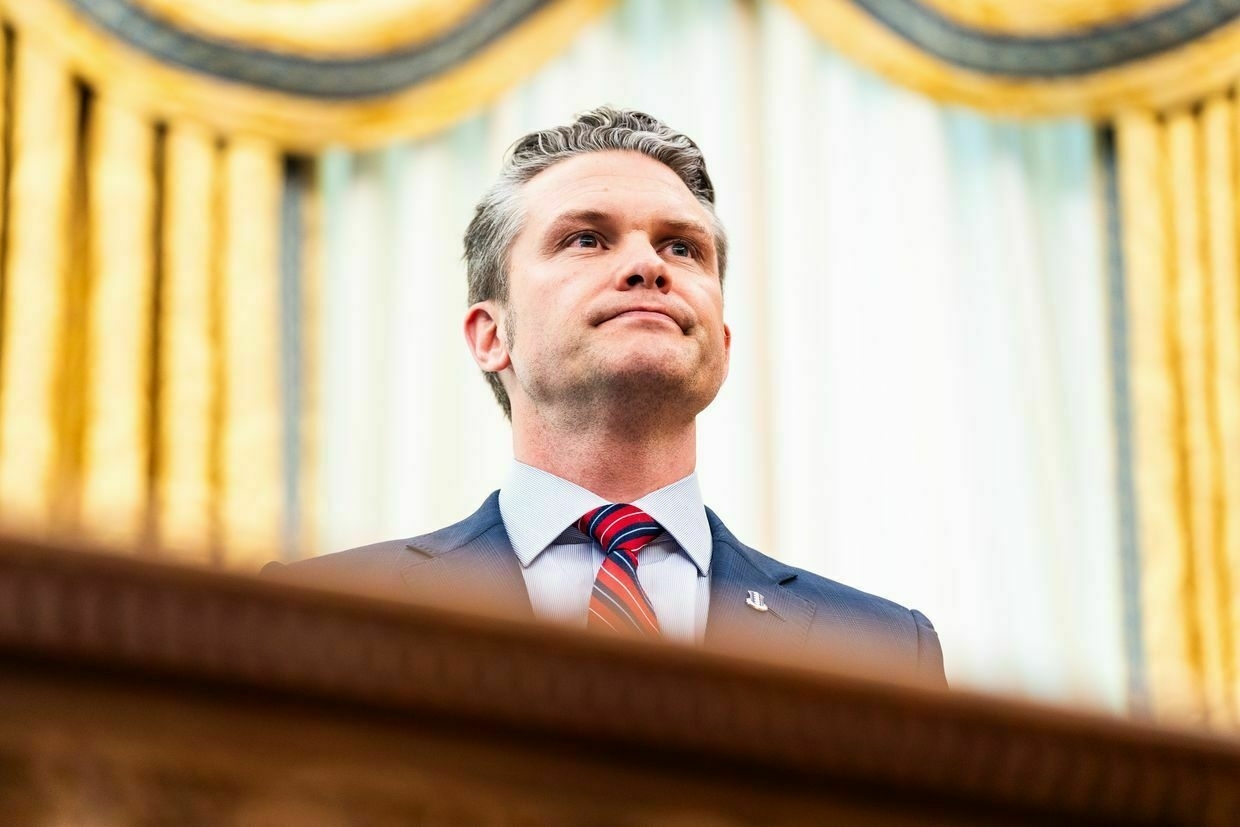
Ukraine repatriates bodies of 1,212 fallen soldiersUkraine has brought back the bodies of 1,212 fallen service members, the Ukrainian Coordination Headquarters for the Treatment of Prisoners of War (POW) said on June 11.
The announcement follows Russian-Ukrainian Istanbul talks on June 2, which focused on exchanges of POWs and fallen soldiers.
The repatriation was carried out through a coordinated effort involving the Security Service of Ukraine (SBU), the Armed Forces, the Interior Ministry, the Ombudsman's Office, the State Emergency Service, and other national security and defense institutions. The International Committee of the Red Cross also supported the operation.
The remains of soldiers were returned from multiple front-line regions, including Kharkiv, Donetsk, Luhansk, Zaporizhzhia, Kherson, and Sumy oblasts.
Officials emphasized that investigative and forensic teams from the Interior Ministry and the Health Ministry are working to identify the bodies in the shortest possible time.
Vladimir Medinsky, aide to Russian President Vladimir Putin, claimed Russia transferred the bodies of 1,212 Ukrainian soldiers in accordance with the agreements in Istanbul, while Ukraine released the remains of 27 Russian service members.
The Ukrainian side did not disclose how many Russian bodies were handed over in return.
At the Istanbul meeting on June 2, Russian and Ukrainian delegations agreed on a new exchange of POWs but failed to reach a ceasefire agreement.
The Turkey-hosted talks were the second round since mid-May and resulted in an agreement to exchange severely wounded and young prisoners, with President Volodymyr Zelensky saying up to 1,200 individuals could be returned on each side. Russia also pledged to transfer up to 6,000 bodies of Ukrainian soldiers.
Following the Istanbul talks, Ukraine and Russia have already conducted two prisoner exchanges on June 9 and 10. While exact figures were not immediately disclosed, Ukraine confirmed the return of severely wounded and chronically ill prisoners, including those captured during the 2022 siege of Mariupol and held for more than three years.
In Istanbul, Ukraine also submitted a peace proposal that called for a full ceasefire, an "all-for-all" POW exchange, the return of abducted children, and the use of frozen Russian assets to rebuild Ukraine. Russia has yet to formally respond.
‘Ukrainians have been stripped of illusion of control’ — Filmmaker Kateryna Gornostai on Russia’s war, cinema and reclaiming the narrativeWhen Russia launched its full-scale invasion of Ukraine, film director Kateryna Gornostai found herself questioning whether she would continue working. “I had this feeling that life — at least professionally — had come to an end,” she says. “Who needed directors or screenwriters, then? At most, volunteers were needed, but hardly anyoneThe Kyiv IndependentKateryna Denisova

Ukraine's SBU releases fresh video of Operation Spiderweb, teases 'new surprises'The Security Service of Ukraine (SBU) released on June 11 a new video detailing the sequence of its mass drone strike against Russia's strategic aviation earlier this month.
The Operation Spiderweb, carried out on June 1, involved 117 drones that were hidden in trucks across Russia and deployed against four air bases, some thousands of kilometers from the Ukrainian border.
The strike deep in the rear damaged 41 aircraft, including Tu-95, Tu-22M3, and Tu-160 bombers, rare A-50 spy planes, and An-12 and Il-78 transport aircraft, causing damage of over $7 billion, the SBU said.
Trucks, seen in the footage driving in an undisclosed location, first transported first-person-view (FPV) drones and wooden cabins to Russia, the SBU said. Already on Russian territory, the vehicles were loaded with cabins, which, in turn, carried the drones.
0:00/A video detailing Ukraine's Operation Spiderweb on June 1, 2025. (SBU) The preparations were taking place in the Russian city of Chelyabinsk, not far from a Federal Security Service (FSB) office, according to the SBU.
The loaded trucks then drove to multiple locations in the cities of Ivanovo, Ryazan, and in the Murmansk, Irkutsk, and Amur oblasts. The cabins opened remotely at the time of the attack, allowing the drones to strike Russian planes at the Belaya, Olenya, Dyagilevo, and Ivanovo air bases.
The operation was also meant to strike at the Russian air base in Ukrainka in Amur Oblast, but this part of the attack failed.
In the strike, Ukraine deployed drones specially designed by SBU specialists for attacks deep in the rear. Their unique features allowed them to be remotely controlled in real time thousands of kilometers behind the border, an SBU source told the Kyiv Independent.
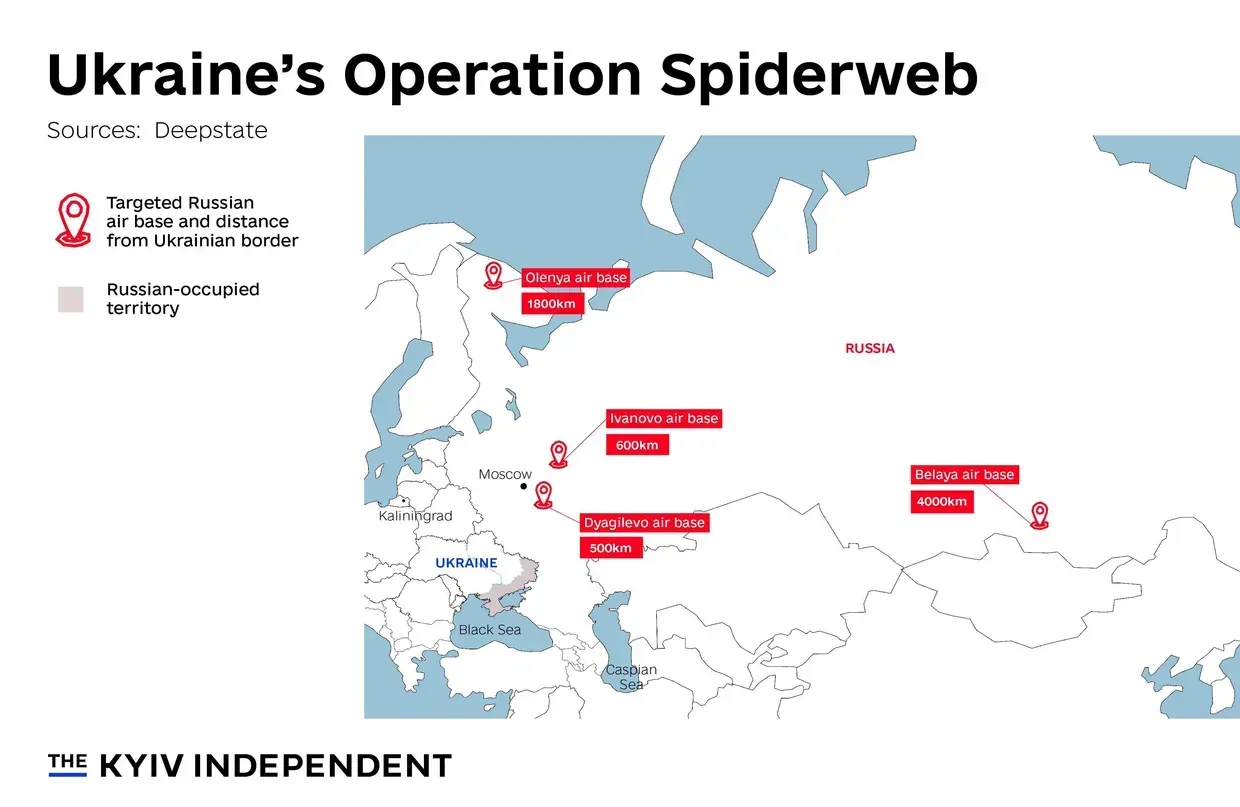
Ukraine's Operation Spiderweb. (Nizar al-Rifai/The Kyiv Independent) The drones' design also helped them "bypass Russian defenses and effectively strike the strategic aviation," the source said.
SBU chief Vasyl Maliuk, who personally oversaw the operation, stressed that Ukrainian drones targeted "absolutely legitimate targets – military airfields and aircraft that attack our peaceful cities."
"The SBU is hitting and will hit (Russia) where it considers itself unreachable!" Maliuk said in a statement.
"We are working on new surprises, no less painful than the Operation Spiderweb."
The attack was lauded by Ukrainian leaders and Western partners, with NATO Admiral Pierre Vandier calling it a reinvention of "the Trojan Horse" method with "technical and industrial creativity."
Various satellite imagery released after the attack showed around a dozen destroyed planes. NATO estimates that between 10 and 13 Russian planes were completely destroyed, and more were damaged.
In turn, President Volodymyr Zelensky claimed that roughly half of the 41 targeted planes have been damaged beyond repair. Russia acknowledged damage to its aircraft but claimed all of them will be "restored."
America’s weak strongmanOver the past two months, financial investors have hit upon a new trading strategy, based on a simple rule: TACO — Trump Always Chickens Out. America’s president threatens to slap massive import tariffs on friends and foes alike, or to remove the Federal Reserve chair, only to back down whenThe Kyiv IndependentTimothy Snyder
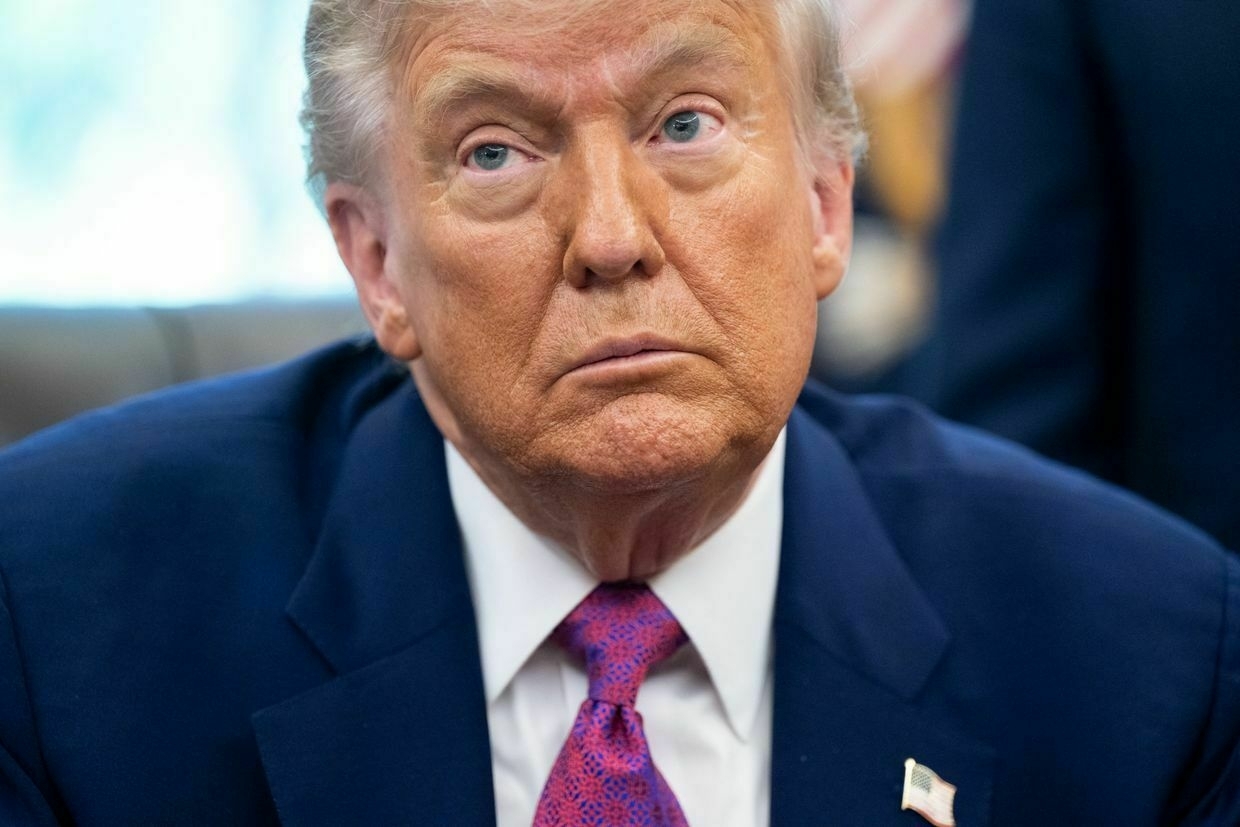
NATO summit statement omits Ukraine's entry bid, $40 billion pledge, Bloomberg reportsA one-page draft of a joint declaration for the upcoming NATO summit omits Ukraine's membership aspirations and last year's pledge of over $40 billion in support, Bloomberg reported on June 11 after reviewing the draft.
This news signals that, for the first time since 2022, Russia's war against Ukraine will not be the chief focus of the annual NATO meeting, which is taking place on June 24-25 in The Hague.
The unusually brief document recognizes Russia as a threat to NATO but not as an aggressor in Ukraine. It also does not mention China, Bloomberg reported.
The communique of the 2024 summit in Washington named Beijing as a "decisive enabler" of Russia's war against Ukraine. Last year's gathering also included a declaration that Ukraine's path to NATO is "irreversible" and promised more than $40 billion in additional military aid.
This year, the document will solely focus on defense spending, as U.S. President Donald Trump pushes NATO partners to hike the military expenditure benchmark from 2% to 5% of GDP.
The final version of the statement can still change, Bloomberg reported.
The brevity of the communique and the summit itself, as well as the decreased focus on Ukraine, stems from the effort to avoid conflict between Trump and European allies.
In a sharp break from former U.S. President Joe Biden, the Trump administration has not approved any new military aid packages to Ukraine and signaled its intent to reduce assistance for Kyiv in the next year's budget.
The U.S. president initially vowed to broker a peace deal between Kyiv and Moscow but became increasingly less engaged in the process as the negotiations stalled and Russia only intensified its attacks against Ukraine.
According to Bloomberg, NATO allies will pledge to allocate at least 3.5% of GDP to defense needs and 1.5% to protecting infrastructure and civil preparedness by 2032. Member states will also consider counting their contributions to Ukraine as part of the new defense spending targets, the news outlet reported.
The summit was preceded by rumors that President Volodymyr Zelensky would not be invited to participate for the first time due to U.S. opposition.
Later, the speculations were dispelled after the Dutch media reported that NATO Secretary General Mark Rutte had invited the Ukrainian leader to attend.
Note from the author:
Ukraine War Latest is put together by the Kyiv Independent news desk team, who keep you informed 24 hours a day, seven days a week. If you value our work and want to ensure we have the resources to continue, join the Kyiv Independent community.
-
EU, Germany boost Ukraine's energy efficiency fund with 18 million euros
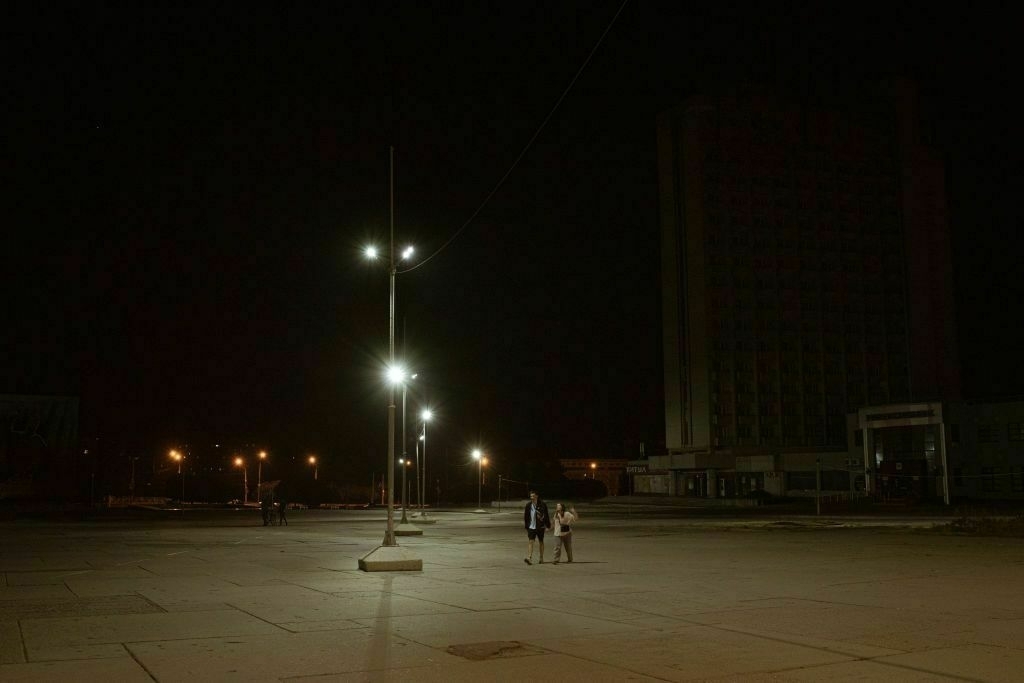
The EU and Germany have topped up Ukraine’s Energy Efficiency Fund (EEF) with an additional 18 million euros ($20.7 million) to expand their support for Ukraine’s energy independence and green recovery, the EU Delegation to Ukraine said on June 11.
The move was announced at the 10th meeting of the delegation’s Coordination Council in Kyiv.
The EU provided 13 million euros ($15 million) of the new funding, while Germany’s International Climate Initiative (IKI) provided 5 million euros ($5.7 million).The International Finance Corporation (IFC), the investment arm of the World Bank, will continue to manage the EEF’s trust fund.
The fund, established in 2019, is split into two programs: VidnovyDIM, which helps repair war-damaged homes, and EnergoDIM, which co-finances grants to cut energy consumption and costs by installing new insulation, windows, and heating systems.
“Today, when Russia is shelling Ukrainian homes almost every night, the VidnovyDIM Fund program helps families cover the costs of repairing walls, roofs, and windows so that they can return home safely and with dignity,” EU Ambassador to Ukraine Katarina Maternova said.
“In parallel, through the EnergoDIM program, we continue to support the thermal modernization of old buildings, which allows us to reduce energy consumption and monthly costs.”
Since 2021, the fund has grown from 90 projects to 1,500 projects, in cooperation with homeowners’ associations, and helped Ukraine save 300 kilowatts per hour in energy consumption– as much as the city of Chernivtsi consumes. The EEF has helped over 217,000 families modernize and repair their homes, of which half were covered by the VidnovyDIM program.
The new financing will improve the efficiency of grants, raise the grant size to meet demand, and help more people under Ukraine’s environmentally sustainable “Build Back Better” principle. The grant limit should increase to more than 200,000 euros, said Ukraine’s Development of Communities and Territories First Deputy Minister Alena Shkrum.
The EFF will now be able to resume requests, which were paused due to the high number of applications. Around 10% of Ukraine’s housing stock has been damaged or destroyed, while much of the country’s heating system is from the Soviet era and inefficient, with apartments unable to control the heating in the winter.
Ukraine’s energy grid has been targeted relentlessly by Russian attacks, causing widespread energy instability across the country. At the same time, bills have increased for electricity and heating, frustrating citizens who have already taken a financial hit due to the war.
The fund has modernized homes and schools to become more energy efficient, which not only cuts costs but also retains warmth during blackouts, said the Shkrum. More Ukrainians are beginning to understand the importance of energy efficiency due to Russian attacks, “which is why the fund should continue functioning, reforming, and developing further,” she added.DTEK to build one of Europe’s largest energy storage facilities, company announcesUkraine’s largest private energy company DTEK secured a $72-million loan to build one of the largest battery energy storage complexes in Eastern Europe, the company said on June 3.The Kyiv IndependentDominic Culverwell
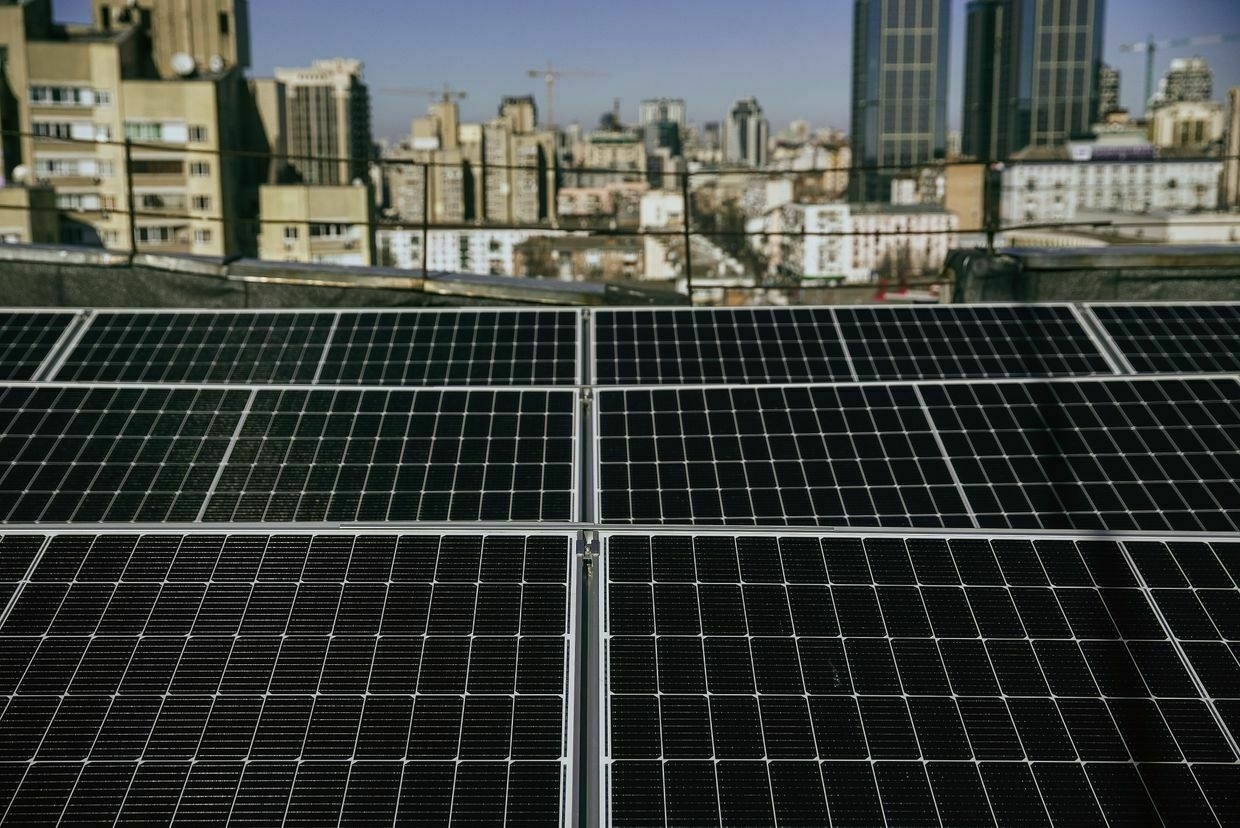
-
Russian factories continue to BURN: Gunpowder plant hit by Ukrainian drones | NEWS PULSE
-
Ukraine bracing for 'painful' reduction in US military aid after Hegseth announces cuts

Editor’s note: For security reasons, the real names of the soldiers mentioned in this story have not been used.
A reduction in U.S. military aid to Ukraine would be “painful” and could have potentially “dire consequences” for the global order, Ukrainian lawmakers and soldiers have told the Kyiv Independent.
U.S. Defense Secretary Pete Hegseth on June 10 signalled the move is almost certain to happen as he discussed Washington’s defense budget for 2026 during a congressional hearing.
Highlighting the Trump administration’s “very different view” of the war in Ukraine compared to that of Joe Biden’s, Hegseth insisted a “negotiated peaceful settlement is in the best interest of both parties and our nation’s interests."
Though he didn’t reveal specific details of the cuts, Ukraine is already bracing for its effects and looking for options to fill the likely sizable gap in support, lawmaker Iryna Friz, a parliamentary committee member on national security, defense, and intelligence, told the Kyiv Independent.
Friz said there is a “whole range” of military aid that Ukraine simply cannot obtain from other Western allies, and any reduction in these capabilities will be “painful."
“But I am convinced that instead of being emotionally affected by such statements (from Hegseth) or frustrated, Ukraine must demonstrate its readiness to strengthen its defense capabilities and increase communication with its partners to continue to defend its sovereignty,” Friz added.
Changes in the U.S. approachWith U.S. President Donald Trump’s return to the White House, Washington has sharply shifted its policy toward Ukraine. Even though Ukraine still receives military aid approved by the Biden administration, and intelligence continues to flow, Trump has already temporarily halted both once, and no new aid packages have been announced in the almost five months of Trump’s presidency.
Ukraine continues to hold the line against Russia’s grinding and slow advances, but any reduction in U.S. aid will likely affect Kyiv’s ability to fight back against Moscow’s forces, as well as undermining ongoing U.S.-led peace efforts.
“This reduction of military support might undermine our defensive capabilities, which, in turn, might translate into more casualties both among our soldiers and civilians,” lawmaker Oleksandr Merezhko, the chair of the parliament’s foreign affairs policy, told the Kyiv Independent.
“When (Russian President Vladimir) Putin is preparing for a summer offensive, according to some sources, it sends the wrong signal, because Putin might take it as encouragement to double down on the war efforts,” Merezhko added.
Ukraine’s SBU releases fresh video of Operation Spiderweb, teases ‘new surprises’“The SBU is hitting and will hit (Russia) where it considers itself unreachable!” SBU chief Vasyl Maliuk said. “We are working on new surprises, no less painful than the Operation Spiderweb.”The Kyiv IndependentMartin Fornusek
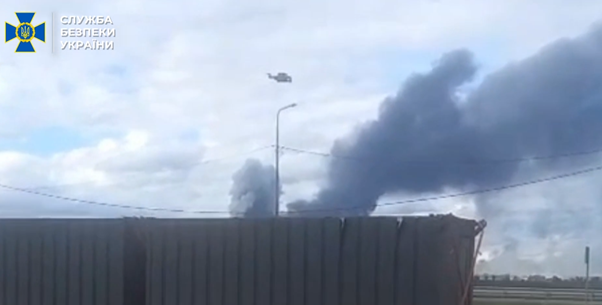
The equipment gapSince the start of the full-scale invasion, the U.S. has given Ukraine around $74 billion in military aid, and has provided weapons that have changed the course of events both on the front line and in cities hundreds of kilometers away from it.
Washington has sent Ukraine several million rounds of ammunition, tanks, armored vehicles, long-range ATACMS missiles, HIMARS, and cutting-edge Patriot air defense systems that are Ukraine’s only effective defense against Russian ballistic missiles.
But under the Trump administration, as well as not receiving new military aid packages, some weapons that were intended for Ukrainian troops have been diverted elsewhere.
According to Zelensky, while then-Defense Secretary Lloyd Austin was in the office, the U.S. pledged to give Ukraine 20,000 missiles to defend against Shahed-type drones, which Russia launches almost every night against Ukrainian cities.
“It was inexpensive, but it is a special technology. We were counting on these 20,000 missiles,” Zelensky said in an interview with ABC published on June 8.
“This morning, my defense minister told me that the U.S. has moved them to the Middle East."
Ukrainian soldiers interviewed by The Kyiv Independent criticized Washington’s recent moves but were not surprised.
“Trump and his entire team are ridiculous cowards. They want to make a deal with (Vladimir) Putin on his terms and sacrifice part of Ukraine. It is more profitable for them,” Bart, a Special Forces sniper fighting in Ukraine’s East, said.
“Reducing American aid is bad for the front line. We depend on it, on their intelligence,” he added.
Ihor, a Ukrainian soldier who also serves on the eastern front, echoed Bart’s stance, adding the new U.S. policies will have “dire consequences” for the global order.
“The U.S. is positioning itself as weak, which will allow dictatorships worldwide to increase pressure (on other countries), and America will not interfere,” he said.
What comes next?In light of the U.S,’s shifting stance, Ukraine’s European allies have pledged to step up military support but countries on the continent are dogged by a decades-long underinvestment in defense production capability.
Ukraine is therefore looking for other options, such as developing its own domestic military production and purchasing American weapons with the help of European partners.
In early June, a Ukrainian delegation led by Presidential Office head Andriy Yermak visited the U.S. to discuss further support for Ukraine’s defense and potential purchases of American weapons.
“We are ready to buy some of it, especially missile defense equipment. The congressmen understand (the issue) and want to move forward with providing Ukraine with everything it needs,” Yermak said on June 6 on national television.
However, following the Ukrainian delegation’s visit, there has been no further action or response from Washington on potential arms supplies or weapons sales to Ukraine and its allies.
Natalia Yermak contributed to this story.
America’s weak strongmanOver the past two months, financial investors have hit upon a new trading strategy, based on a simple rule: TACO — Trump Always Chickens Out. America’s president threatens to slap massive import tariffs on friends and foes alike, or to remove the Federal Reserve chair, only to back down whenThe Kyiv IndependentTimothy Snyder
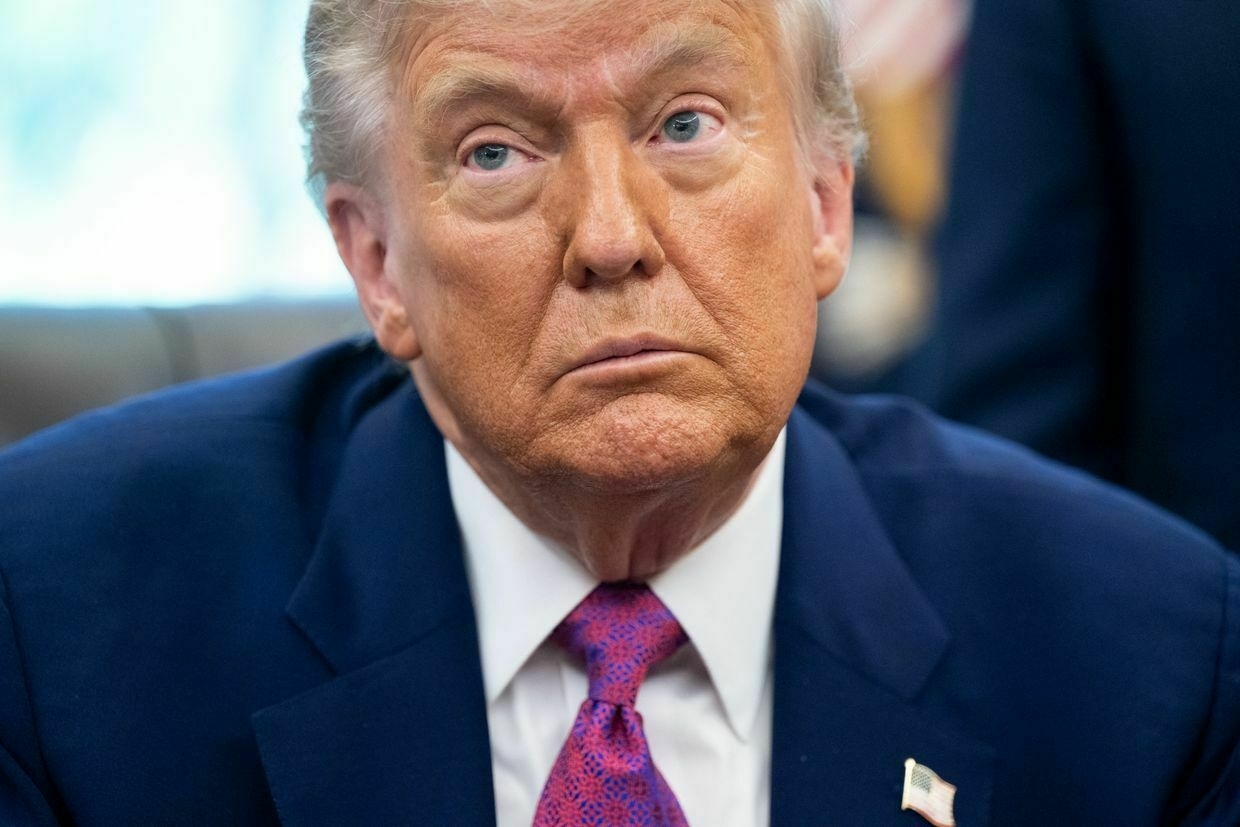
-
Russia wants to seize Odesa! Zelenskyy urged to increase support for Ukraine #shorts
-
'Ukrainians have been stripped of illusion of control' — Filmmaker Kateryna Gornostai on Russia's war, cinema and reclaiming the narrative

When Russia launched its full-scale invasion of Ukraine, film director Kateryna Gornostai found herself questioning whether she would continue working.
“I had this feeling that life — at least professionally — had come to an end,” she says. “Who needed directors or screenwriters, then? At most, volunteers were needed, but hardly anyone involved in filmmaking."
The urgency of documenting the war soon became clear, but emotionally picking up a camera didn’t come easily. The 36-year-old filmmaker struggled with fear and doubt, knowing any shot she filmed could be her last.
“It felt scary that you’re filming, and these could be your last shots because now a missile will hit here. And that’s all that will be left of you."
Yet, she did return. In 2023, Gornostai began working on her first film following the start of the full-scale war.
Her latest documentary “Timestamp,” was screened at the 75th Berlin International Film Festival — making her the first Ukrainian director in nearly three decades to compete for the Golden Bear. The last was Kira Muratova’s “Three Stories” in 1997.
Gornostai attended the Berlinale only briefly, arriving just for the film’s screening on Feb. 20, days after giving birth to her son.
“Timestamp” follows students and teachers across different parts of Ukraine, including cities regularly pounded with Russian missiles and drones, showing what everyday school life looks like in the war-torn country.
The film is both intimate and unflinching, offering a glimpse into how kids endure the hardship of growing up under constant bombardment.
Gornostai dedicated the film to her younger brother Maksym, killed in action in 2023 while she was still filming.
On June 11, the movie premiered in Ukraine.
“It should be both fun and sad at the same time,” she told the Kyiv Independent days before the screening. “That’s what we hope for."
Author Yuri Andrukhovych on Ukrainian dissident art in Soviet timesIn Soviet times, being a pro-Ukrainian artist was dangerous. The Soviet secret police were particularly brutal in Ukraine, given that it was a country with a long history of resistance to Russian rule. Still, new generations of artists remained committed to their culture in the face of widespread Russification. AmongThe Kyiv IndependentKate Tsurkan
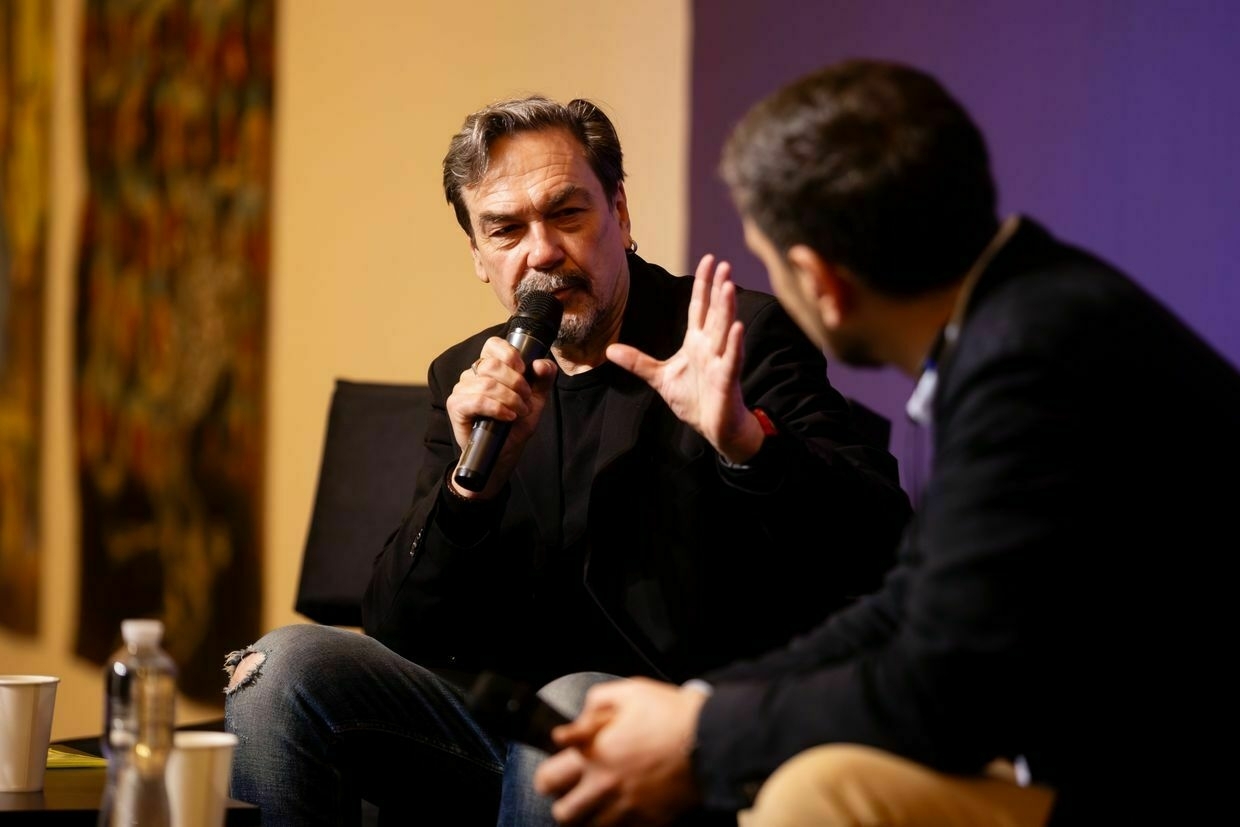
Childhood and warThemes of school and adolescence are in the spotlight of Gornostai’s work, with autobiographical and personal elements running through it.
Just over a month before Russia launched its all-out invasion, Gornostai’s debut feature film “Stop-Zemlia” premiered in Ukraine in January 2022. The movie earned recognition both at home and abroad, winning the Crystal Bear in the Berlinale Generation 14plus section, a category for movies that explore the life of children and teenagers.
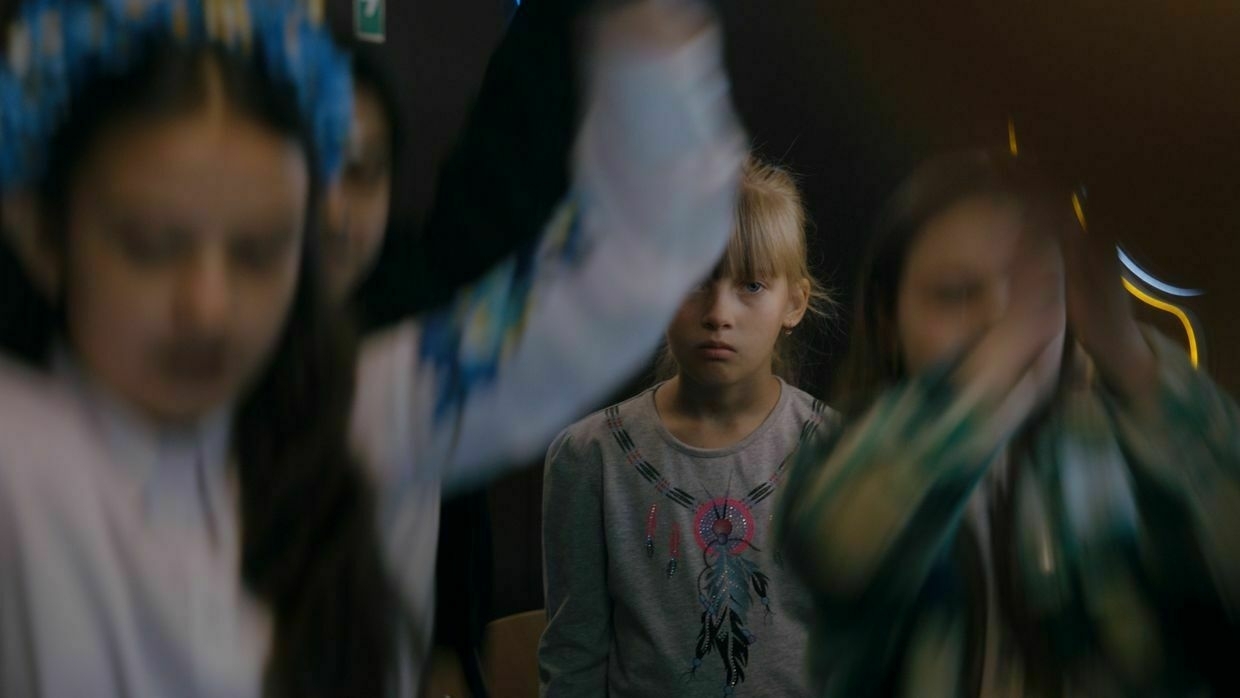
A screenshot from “Timestamp” documentary, Gornostai’s latest film, that was screened at the 75th Berlin International Film Festival. (Timestamp) “Timestamp” has the same focus, yet different story, showing a new reality that Ukrainian education is facing — remote learning, damaged infrastructure, constant air raids, studying in the subway, and the psychological trauma of kids at war.
One of the most important scenes in the film for Gornostai is the funeral of the school principal in the town of Romny, Sumy Oblast, killed in a Russian drone strike on the local school in August 2023.
It’s the only moment in the film where Russia is directly accused of aggression against Ukraine, the phrase spoken by a priest.
“Because already, so much pain has touched nearly every person. Everyone has experienced some kind of loss — from their homes to their loved ones. Many have lost the most precious thing of all: life itself.”
"This school didn't live to see its hundredth anniversary, which would've been next year. It survived World War II, but it didn't survive this war," Gornostai says.
Since the full-scale invasion of Ukraine, around 3,500 educational institutions have been damaged, and around 400 completely destroyed, Deputy Education Minister Yevhen Kudriavets said in late February of 2024.
Turning pointThe Euromaidan Revolution was a turning point for Ukraine — and for a new generation of filmmakers, including Kateryna Gornostai.
She was studying in Moscow at the time of the Maidan protests in 2013 but returned to Kyiv to document the unfolding events.
"We all started making documentaries that explored civil society," she says. "It was a moment of growth — personal and professional. You're filming real events but also thinking about how they'll come together as a story."
She made two documentaries during that time — "Maidan is everywhere" and "Euromaidan." Rough Cut, of which she was a co-author. While many turned their cameras toward the front lines of Russia's war in Ukraine's east that followed, Gornostai chose a different path.
"I'm very scared," she admits. "Even on Maidan, I couldn't stand between the Berkut (riot police) and the protesters like some of our colleagues. I stayed in the rear, and I remember thinking — there are stories here, too."
More than a decade later, she sees that moment as the foundation of a powerful wave of Ukrainian cinema.
"(The Euromaidan Revolution became) a separation from that post-Soviet, Eastern European blend — because it used to feel like our cinema was perceived as part of Russian cinema prior.
Russian propagandaDuring the interview, Gornostai's tone sharpens when the conversation turns to Russia's cultural influence.
For decades, Moscow cast a long shadow over Ukrainian cinema. Even after Ukraine's independence, Russian money and distribution networks kept a grip on the country's film industry.
That influence didn't vanish with the invasion — it just evolved. Since the start of the war шт 2014 against Ukraine, Russia's film industry has shifted to propaganda.

A portrait of Kateryna Gornostai after the interview in Sens bookstore in Kyiv, Ukraine on June 2, 2025 (Elena Kalinichenko/The Kyiv Independent) Yet, Russian films still screen at major international festivals, and Russian actors who support the war against Ukraine continue to win awards.
"Movies are just one small part of a much bigger (Russian) cultural push," Gornostai says.
"In fact, there is a huge campaign that has lasted for many, many decades, involving enormous financial resources, all aimed at creating an image (abroad). This is something that we (in Ukraine) have not done. And what we are trying to do now is to build some kind of postcolonial lens through which Ukraine should now be seen."
“Most of the films that have been screened somewhere weren’t made thanks to the circumstances in Ukraine, but rather in spite of them.”
Abroad, she says, fascination with Russian culture persists, while the understanding of Ukraine still lags behind.
"The fact that there are signs of genocide committed by Russia and that the Holodomor could have already been recognized as a genocide a century back — very few people know that abroad. But they do know the great Russian ballet, literature — all those things that were deliberately built up, promoted, and became part of a certain stereotype."
According to Gornostai, for a long time, there was a prevailing belief in Ukraine that the answer to Russian propaganda should be counter-propaganda. But she thinks that Ukraine should be creating high-quality cinema, not propaganda of its own.
"We simply need something completely different that will make us stand out and represent ourselves on the international stage. I think quality is very important now in this world," she adds.
Gornostai believes that the current crisis in Ukrainian cinema stems more from domestic policy than the war itself. Even before Russia’s full-scale invasion, government inaction had weakened the industry.
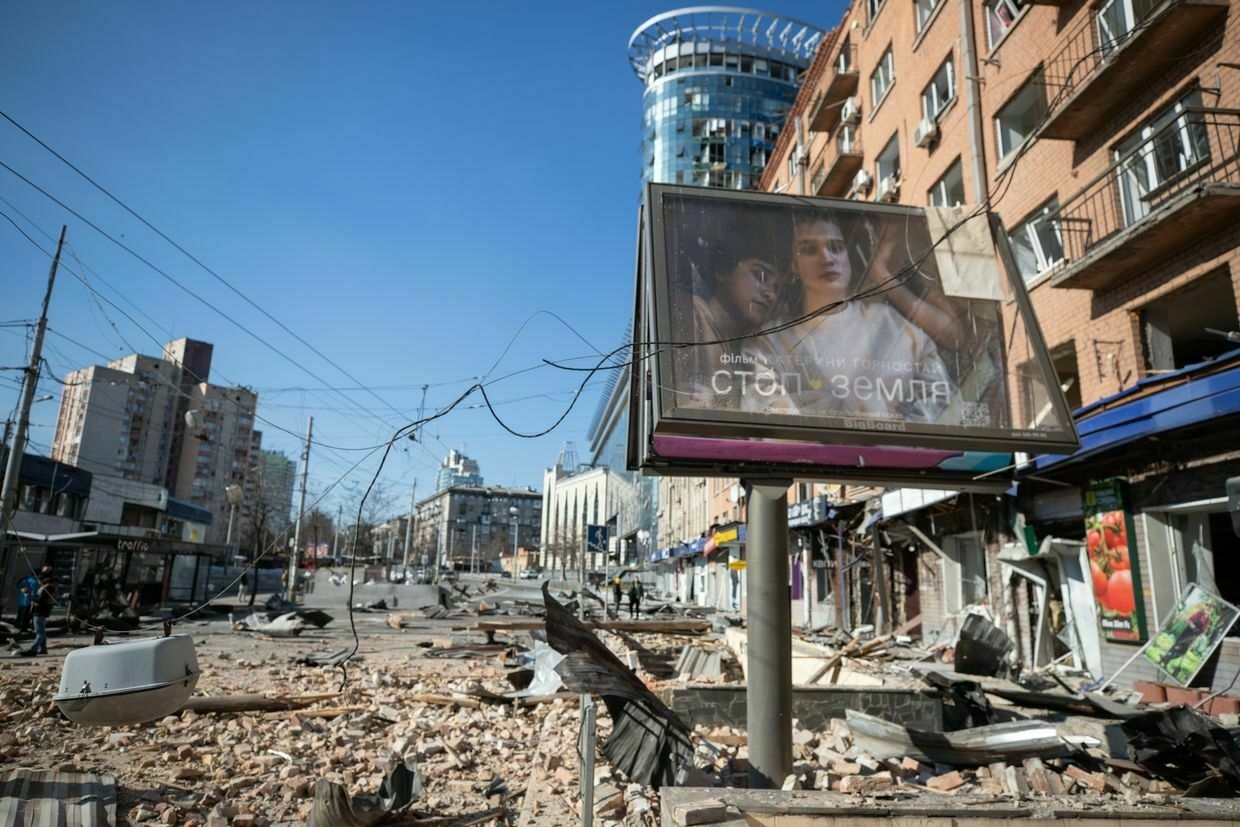
Debris from damaged buildings lies in the street and a destroyed billboard with Gornostai's movie "Stop-Zemlia" after shelling near Lukianivska metro station in Kyiv, Ukraine, on March 14, 2022. (Oleksii Samsonov / Global Images Ukraine via Getty Images) Following the invasion, funding for the State Film Agency was slashed. In 2025, only Hr 204.1 million ($4.9 million) is allocated, nearly 70% less than in 2024.
“Most of the films that have been screened somewhere weren’t made thanks to the circumstances in Ukraine, but rather in spite of them,” says Gornostai. “They were funded either by private money, individual initiatives, or through international grants, producers, or festival pitching awards that made production possible. Documentary filmmaking can survive in this way.”
A standout example is “20 Days in Mariupol” by director Mstyslav Chernov, which documented the Russian siege of the city in 2022 and won Ukraine’s first Oscar in 2024 for Best Documentary.
“This is a huge victory for the truth itself. It preserves and engraves the history of Mariupol and no one will be able to distort it anymore,” Gornostai says.
Post-war scriptGornostai's new feature film, "Antonivka," is expected to be released in 2027. Set in the aftermath of Ukraine's victory in the war, the film explores death.
"Even when this war ends, it won't truly be over," says Gornostai. "Because already, so much pain has touched nearly every person. Everyone has experienced some kind of loss — from their homes to their loved ones. Many have lost the most precious thing of all: life itself."
She believes that once the war ends, there will be a difficult period of collective reckoning — a time when people begin to process their grief. Her film, she says, is an attempt to open that conversation.
"There's this ephemeral law that time heals. It works very strangely. It doesn't really heal. That's not the whole phrase," Gornostai says. "Time simply passes, and it's as if layers of new experiences start to build up after that very significant moment in your life — for example, the death of someone close to you. These layers grow, and it's as if they gradually distance you from that moment."
"That's the subject I'm grappling with now — and it's a subject many others are facing too," she continues. "How do we grieve that kind of loss? How do we reflect on it? The film deals with many kinds of deaths, but at its core, one of its central elements is the acceptance of your own death — the one that awaits you."
One of the central figures in the film is an elderly man who lived through famine and war. As Gornostai speaks, she recalls her two grandfathers who passed away.
"Ukrainians have now been stripped of the illusion of control," the filmmaker says. "But still, I'd like to have the privilege of dying at a time when I know that my family will remain here, that people speaking the Ukrainian language will remain here, and that there is peace and life on this land. And that I am leaving it behind. Not dying in a moment of total turbulence and uncertainty about what will happen tomorrow — as if I'm leaving everyone in the middle of that."
"So this is another privilege: a privilege to die in a free country. And this is one of the motivations for making this film."
Wondering where to start with Dostoevsky? Try his Ukrainian contemporaries insteadSince the start of Russia’s full-scale invasion of Ukraine in 2022, a growing debate has emerged over the cultural and political legacy of Russian literature — particularly the global reverence for classic Russian authors, which critics argue has long served to promote the imperial narratives embedded in their work. AsThe Kyiv IndependentKate Tsurkan
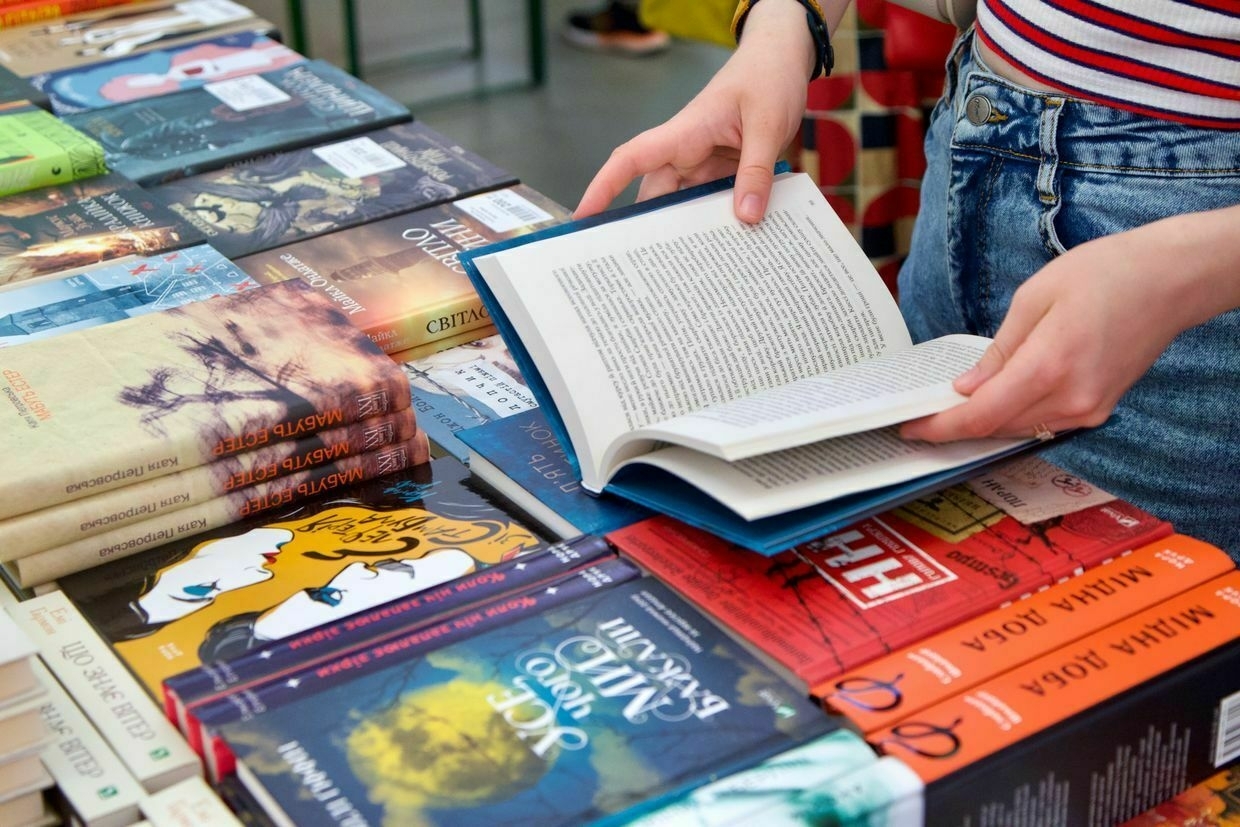
Note from the author:
Hello there! This is Kateryna Denisova, the author of this piece. As Russia’s war against Ukraine grinds on, Ukrainian filmmakers like Kateryna Gornostai are capturing stories that reveal the reality on the ground.
I hope many people will watch these films and learn more about Ukrainian cinema and its directors through interviews like this one.
Your support helps make this work possible. Please consider contributing to sustain our reporting.
-
Zelensky urges 'stronger' EU sanctions on Russia, lower oil price cap
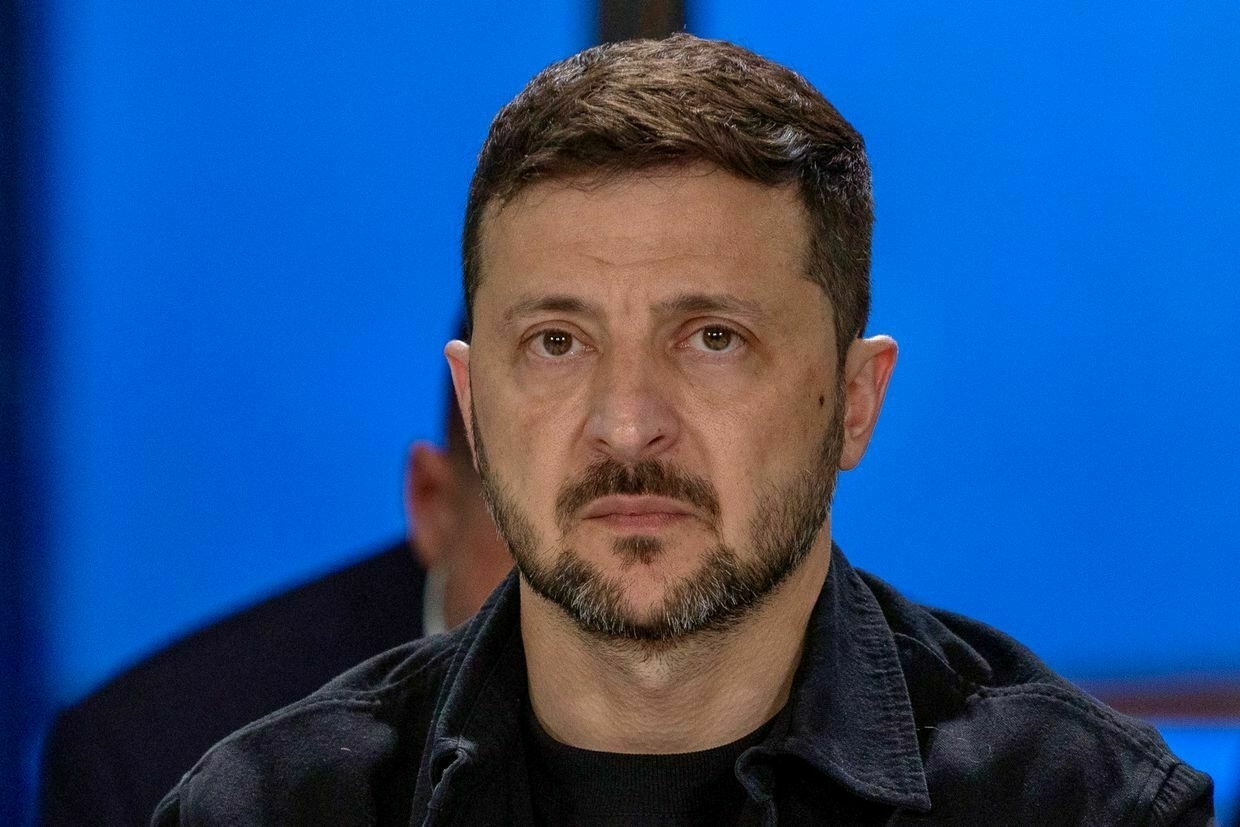
President Volodymyr Zelensky on June 11 called on the European Union to impose tougher sanctions against Russia, arguing that stronger financial pressure is necessary to curb Moscow’s war effort.
Speaking at the Ukraine-Southeast Europe Summit in Odesa, Zelensky said the upcoming 18th EU sanctions package “could be stronger,” especially in targeting Russian oil tankers and the financial sector. He urged the EU to further reduce the price cap on Russian oil exports.
“A ceiling of $45 per barrel of oil is better than $60, that’s clear, that’s true. But real peace will come with a ceiling of $30,” he said. “That’s the level that will really change the mindset in Moscow."
After the 17th package of sanctions against Russia took effect on May 20, Ukraine’s allies announced the following day that another round of restrictions was already in the works.
European Commission President Ursula von der Leyen announced on June 10 that the EU is considering lowering the oil price cap from $60 to $45 per barrel — a measure that will be discussed at the upcoming G7 summit in Canada on June 15–17.
The Kremlin’s budget is increasingly strained by soaring military expenditures, with Russia’s Finance Ministry relying heavily on energy revenues to fund the war against Ukraine.
The push for tighter sanctions comes as Russia continues to reject ceasefire proposals and presses forward with military operations. Zelensky warned that Odesa remains one of Russia’s “main targets,” with plans to push beyond it toward the borders with Romania and Moldova.
“Russia wants to destroy it, as it has done with countless cities and villages in the occupied territories,” he said. “Russian military plans point to this region — Odesa — and then to the border with Moldova and Romania."
Odesa is a major port city in southern Ukraine, located on the northwestern coast of the Black Sea. The president warned of possible destabilization efforts in the broader region, comparing the Kremlin’s strategy to its previous interference in the Balkans.
“We saw this before in the Balkans, where Russia intensified interethnic friction, carried out sabotage, and even attempted coups,” Zelensky said.
The Odesa summit was attended by several southeastern European leaders, including Serbian President Aleksandar Vucic and Romania’s newly elected President Nicusor Dan.
Vucic’s trip marked his first official visit to Ukraine since the start of Russia’s full-scale invasion.
Ukrainian drones strike targets in Russia, including gunpowder plant, General Staff saysThe Tambov Gunpowder Plant, one of Russia’s main manufacturers of gunpowder and explosives for small arms, artillery, and rocket systems, reportedly caught fire following the drone strike.The Kyiv IndependentTim Zadorozhnyy
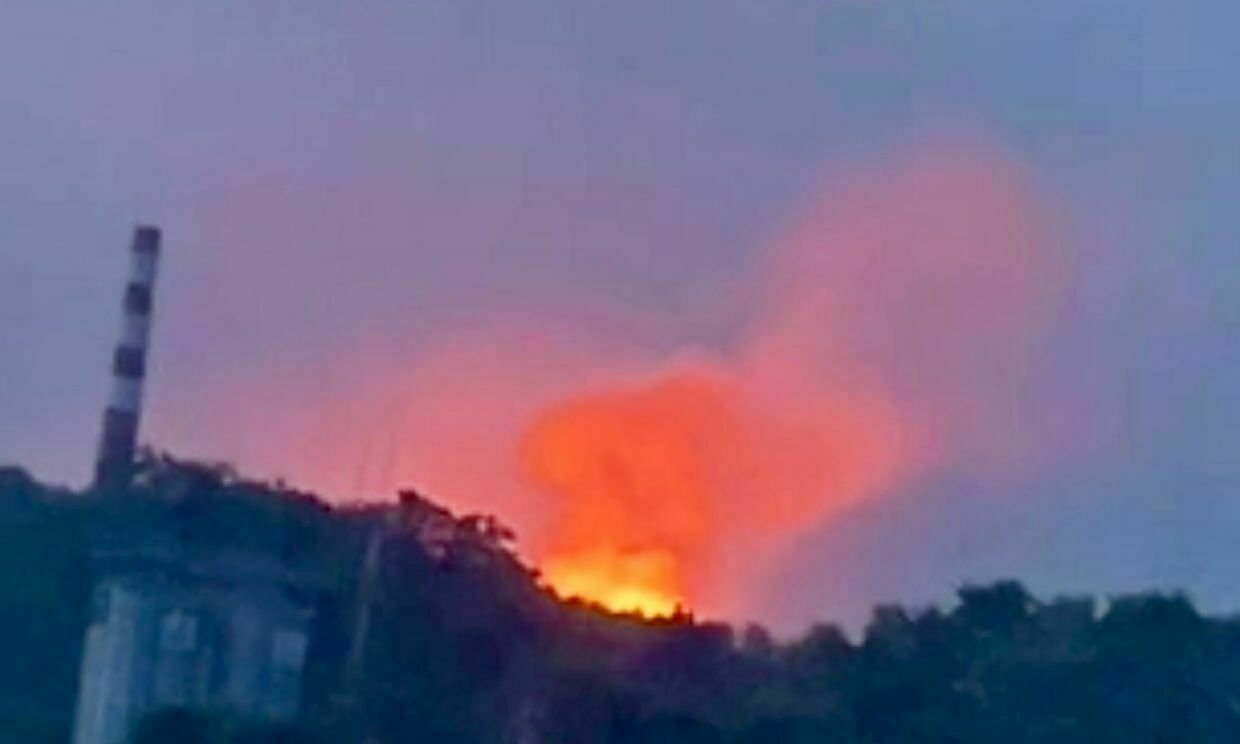
-
Ukraine OBLITERATES Russia’s desperate offensive effort in Kupyansk direction
-
Byline Podcast: #Drone Warfare: Russia’s ‘Human Safari’ and Ukraine’s Operation Spider’s Web
Crimes against Humanity 🇷🇺 Military operation 🇺🇦
-
Investigation on Telegram Hosting Infrastructure
-
Ukrainian drones strike targets in Russia, including gunpowder plant, General Staff says
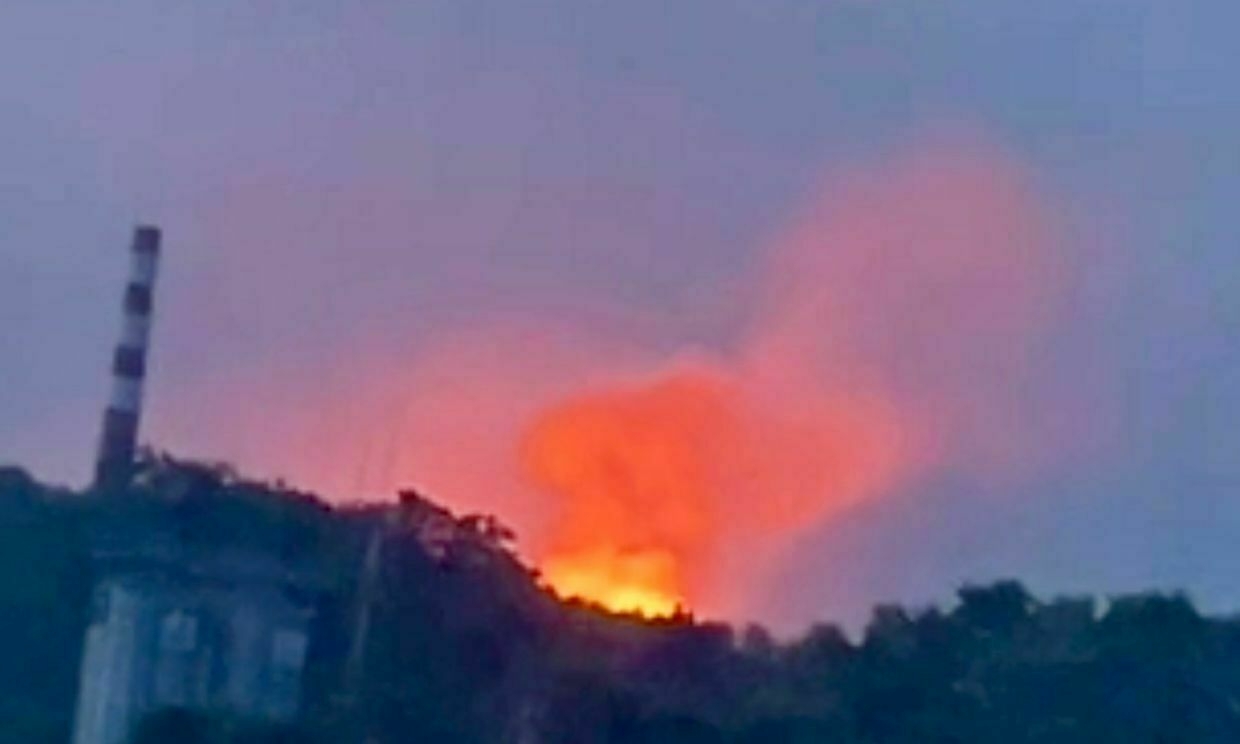
Ukrainian drones struck multiple military targets in Russia, including the Tambov Gunpowder Plant, overnight on June 11, the General Staff of Ukraine’s Armed Forces reported.
The plant, one of Russia’s main manufacturers of gunpowder and explosives for small arms, artillery, and rocket systems, caught fire following the drone strike, according to the General Staff.
Local residents reported hearing explosions and shared videos showing a large blaze near the facility, according to the Russian independent media outlet Astra.
The General Staff described the attack as part of a broader operation to degrade Russia’s ability to produce explosive materials and ammunition used in the full-scale war against Ukraine.
The Tambov facility has been targeted several times since November 2023, and U.S. sanctions were imposed on it that same year. Tambov Oblast, located southeast of Moscow, lies hundreds of kilometers from Ukraine and shares no direct border with it.
Russian state news agency TASS confirmed a drone attack but did not mention the strike on the powder plant. Tambov Oblast Governor Maxim Egorov said that emergency services had extinguished the fire and that there were no casualties, though he did not specify the location of the fire.
In addition to the strike on Tambov, Ukrainian drones hit the ammunition depot of Russia’s 106th Airborne Division in Kursk Oblast and the depot at Buturlinovka airfield in Voronezh Oblast, the General Staff said.
The extent of the damage is still being assessed, the General Staff said.
“The Defense Forces continue to take all measures to undermine the military and economic potential of the Russian occupiers and force Russia to stop its armed aggression against Ukraine,” the statement reads.
Ukraine has ramped up long-range drone strikes in recent weeks, targeting Russian air bases and arms production facilities in an effort to disrupt Moscow’s war machine ahead of an anticipated Russian summer offensive.
As Russia inches closer to Dnipropetrovsk Oblast, new Ukrainian region might soon be at warMoscow said its troops had crossed into Dnipropetrovsk Oblast and were conducting offensive operations in the region, a claim Kyiv quickly denied as “Russian disinformation.” Russian troops have been pushing toward Dnipropetrovsk Oblast for months, trying to solidify the southern flank to capture Pokrovsk and the remaining parts of theThe Kyiv IndependentAsami Terajima
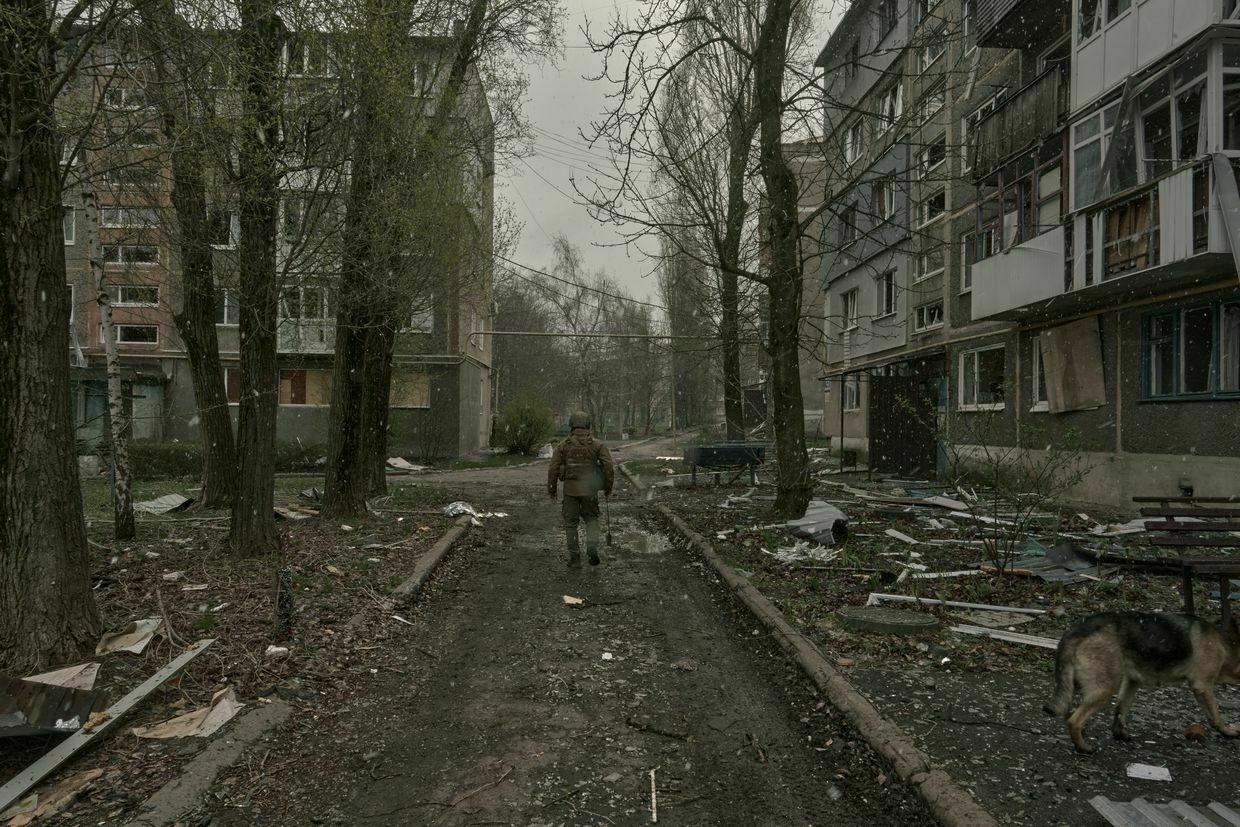
-
America’s weak strongman
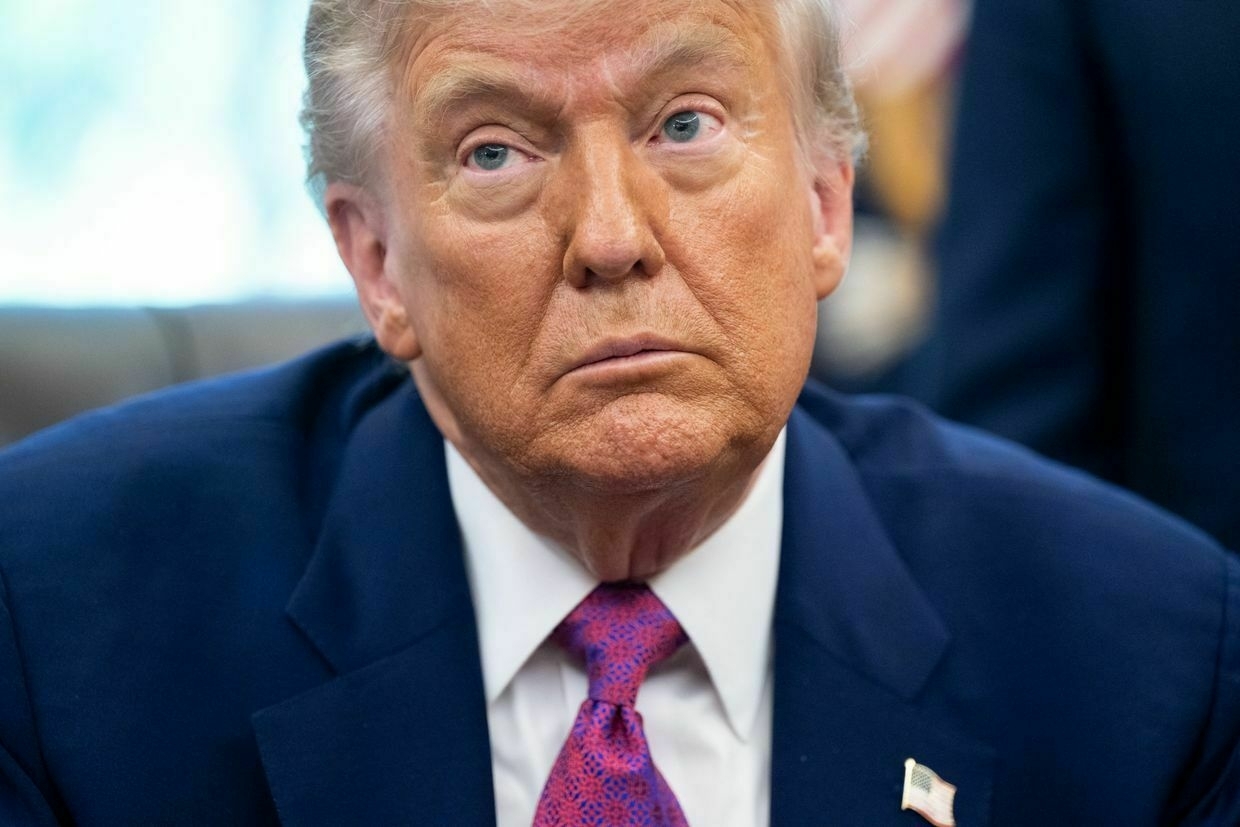
Over the past two months, financial investors have hit upon a new trading strategy, based on a simple rule: TACO — Trump Always Chickens Out. America’s president threatens to slap massive import tariffs on friends and foes alike, or to remove the Federal Reserve chair, only to back down when the whip of the market imposes its uncompromising discipline. Then he switches back to tariffs, only to back down yet again.
It’s a pattern that extends beyond the economy. In fact, it’s the defining feature of Donald Trump’s presidency. But Trump is not just “chicken.” He is a weak strongman, and America’s adversaries may understand that better than most Americans.
Many Americans fear Trump, so they imagine that others must, too. But no one outside America fears Trump as such. America’s friends fear an arsonist — someone who destroys what others have created. And America’s enemies welcome the destruction wrought by Trump and by Elon Musk’s Department of Government Efficiency. When Musk recently stepped down, the leading Kremlin ideologue Alexander Dugin lamented his departure: “DOGE made a great favor to the entire world by liquidating USAID, Health department and Department of education.”
Trump is strong in a relative sense; after he destroys institutions, what remains is his presence. But he is weak because, having destroyed the government departments overseeing money, weapons, and intelligence, the United States has no actual tools to deal with the rest of the world. He plays a strongman on television, and he is a talented performer. But his strength consists solely in his audience’s submissiveness. His performance arouses a dream of passivity: Trump will fix it.
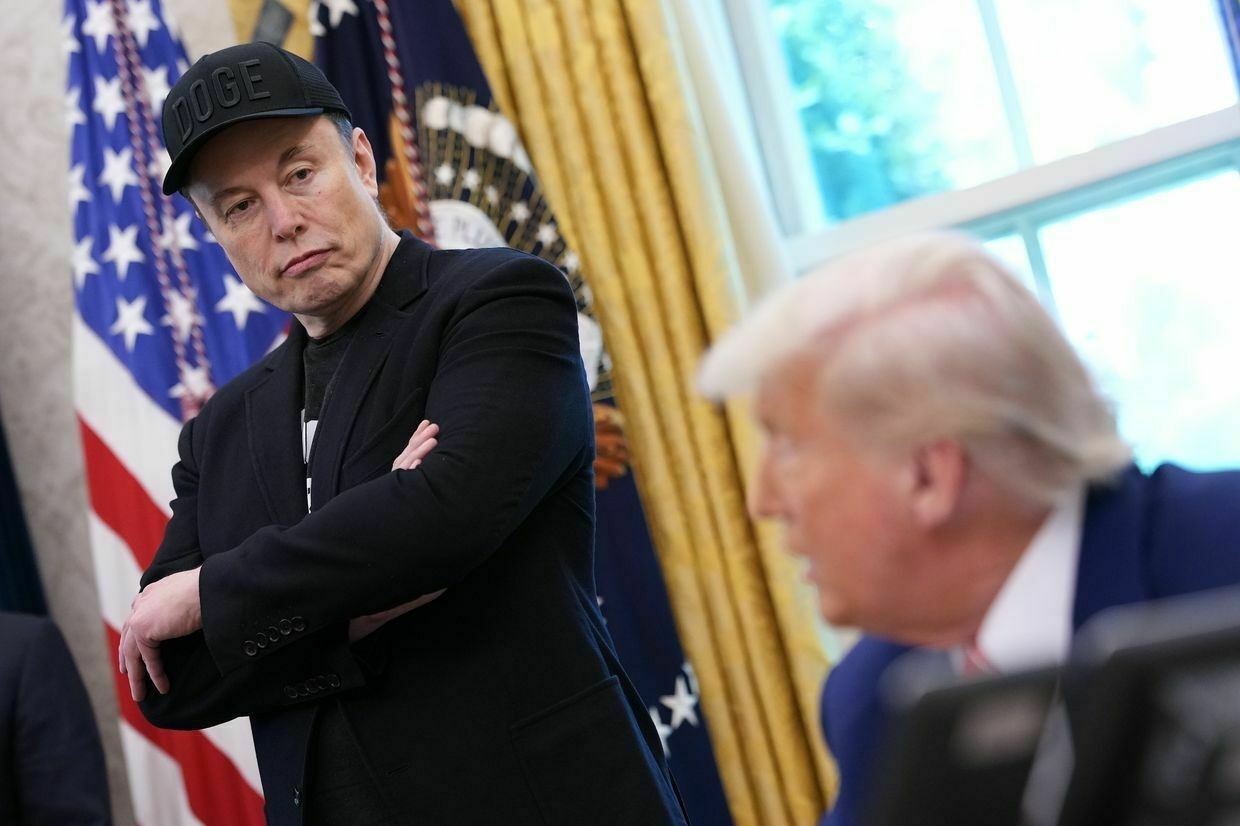
Tesla CEO Elon Musk listens as US President Donald Trump speaks to reporters in the Oval Office of the White House in Washington, D.C., U.S. on May 30, 2025. (Kevin Dietsch / Getty Images) To be sure, Trump’s charisma is a kind of strength. But it cannot be brought to bear on any problem, and it is irrelevant outside the U.S. Trump’s supporters might think that America needs no friends because it can intimidate its enemies without help. But we already know that Trump cannot make Canada or Mexico — much less China, Iran, or Russia — do his bidding.
That only works at home. For years, Trump has used rallies and social media to inspire random violence against his domestic opponents. This has led to a self-purge of the Republican Party and forged a docile cohort of congressional cadres. The people who submit to Trump perceive him as a strongman, but what they are experiencing is their own weakness. And their weakness cannot magically become strength in the wider world.
The capital letters and exclamation points in social-media posts that Trump has directed at Russian President Vladimir Putin in recent months, demanding that he stop the war in Ukraine, have had no effect on Putin’s emotional state, let alone on Russian policy. And inciting stochastic violence won’t work on foreign leaders. No one in Irkutsk is going to threaten or harm Putin because Trump posted something on the internet.
Trump cannot credibly threaten Russia without functioning institutions and competent civil servants.
One could be generous and interpret a Trump post threatening sanctions as an act of policy. But words matter only when there is actually a policy, or at least the possibility that one might be formulated. But for there to be a policy, there must be institutions staffed with competent people. And Trump’s first policy was to fire those who would be competent to design and implement a policy. Many of the people who knew anything about Ukraine and Russia, for example, are simply gone from the ranks of his administration.
Key to Russia’s defeat lies in its economyAs the war in Ukraine grinds on, attention remains fixed on the battlefield. But Russia’s most vulnerable flank is not in the trenches — it’s in the treasury. The West, and especially the United States, holds economic levers that could push Vladimir Putin toward serious negotiations or even collapseThe Kyiv IndependentWojciech Jakóbik
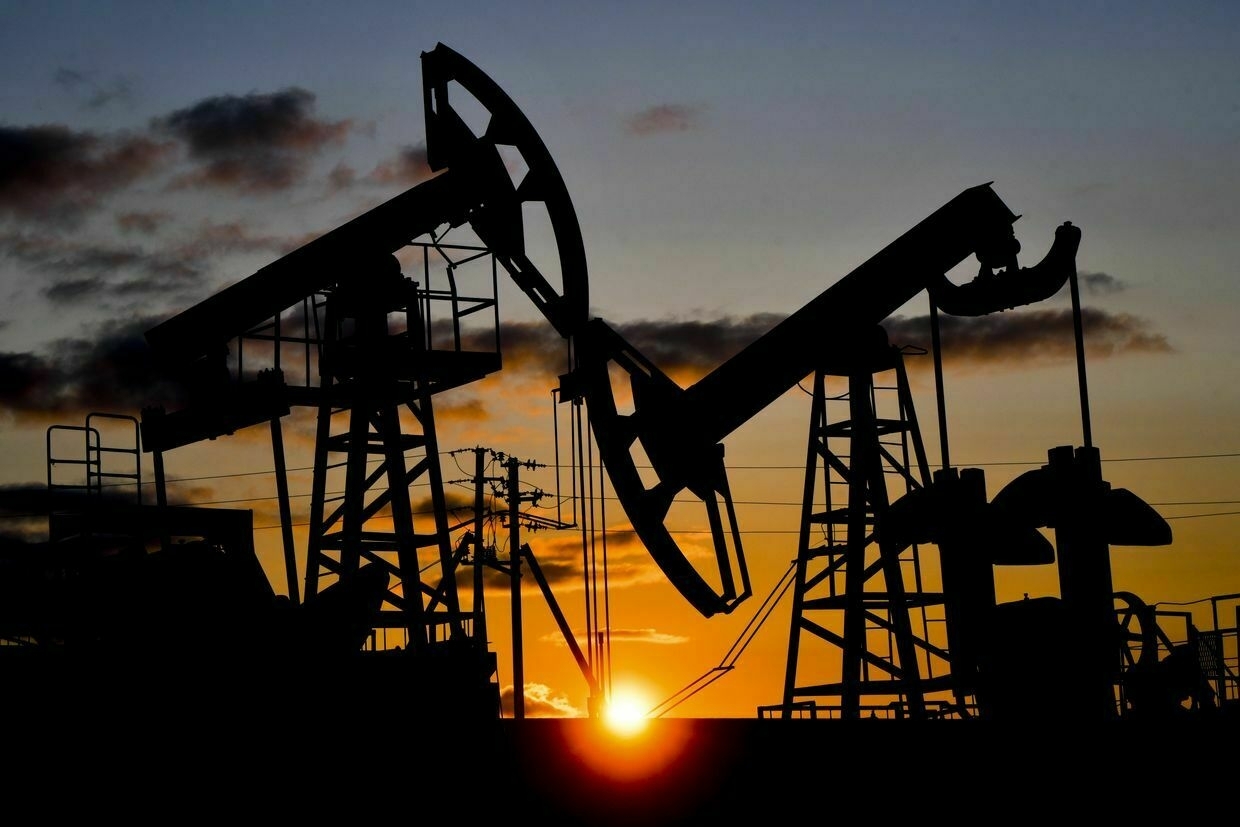
In their place came Trump’s flailing efforts to make concessions to Russia regarding Ukrainian sovereignty on his own — without Ukraine and without any allies. It didn’t work. His position was so weak that Putin naturally assumed he could get more and duly escalated Russian aggression in Ukraine. Trump is a sheep in wolf’s clothing, and the wolves can tell the difference.
It’s an obvious point, but it must be made clearly: no one in Moscow thinks that Trump is strong. Even if he wanted to, Trump cannot credibly threaten Russia without functioning institutions and competent civil servants. To make sanctions work, for example, he would need more people on the job, not fewer. Moreover, foreign powers would need to believe that the Department of the Treasury is more than an American billionaire’s plaything. Unfortunately, their intelligence agencies read the newspapers.
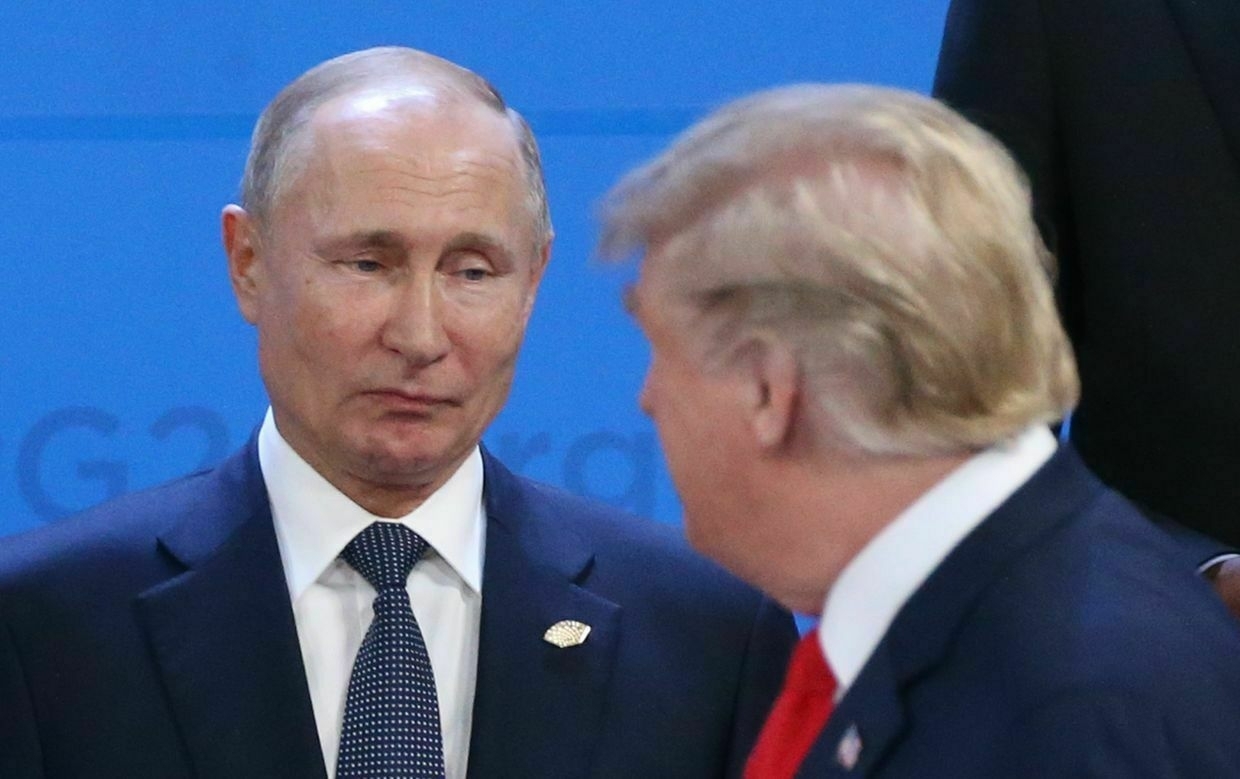
Russian President Vladimir Putin (L) looks at U.S. President Donald Trump during the welcoming ceremony ahead of the G20 summit plenary meeting in Buenos Aires, Argentina, on Nov. 30, 2018. (Mikhail Svetlov / Getty Images) Americans can choose to ignore that the state capacity needed to deal with adversaries has been gutted and/or entrusted to people whose only qualification is absolute fealty to Trump. But the destruction of the institutions of U.S. power creates a very simple incentive structure for America’s enemies. The Russians hoped that Trump would return to the White House precisely because they believe he weakens the U.S. Now, as they watch him dismantle the CIA and FBI, putting the likes of Tulsi Gabbard, Kash Patel, and Pam Bondi in charge of intelligence and federal law enforcement, they can only think that time is on their side.
That is why Putin has ignored Trump’s demand for a ceasefire in Ukraine, and why Russia will use any ceasefire that may occur to prepare for the next invasion. Putin is justifiably confident that a U.S. neutered by Trump will be unable to respond, that the Europeans will be distracted, and that the Ukrainians, after years of war, will find it harder to mobilize again.
What is true for Russia also holds for China. The weak strongman helps the People’s Republic. Time was not really on China’s side before Trump. While a generation of Americans had feared that China would surpass the U.S. economically and militarily, the trend lines in recent years were no longer so clear, or indeed had reversed. But now that Trump has set a course to destroy America’s state capacity, China can simply take what it once would have had to struggle to gain.
Wall Street might profit from the TACO trade in the short term, but a weak strongman brings only losses. While Trump’s supporters might be tempted to believe that he has made America a titan among nations, the opposite is true. As a strongman, Trump destroys the norms, laws, and alliances that held back war. As a weakling, he invites it.
Editor’s Note: Copyright, Project Syndicate. This article has been republished by the Kyiv Independent with permission. The opinions expressed in the op-ed section are those of the authors and do not purport to reflect the views of the Kyiv Independent.
Western hesitation continues to undermine UkraineOn May 28, President Volodymyr Zelensky visited Germany and met with the country’s new Chancellor, Friedrich Merz. There were high expectations that Berlin would finally authorize the delivery of Taurus long-range missiles — a long-standing request from Kyiv since the beginning of the Russian invasion. However, this demand had beenThe Kyiv IndependentUria Fancelli
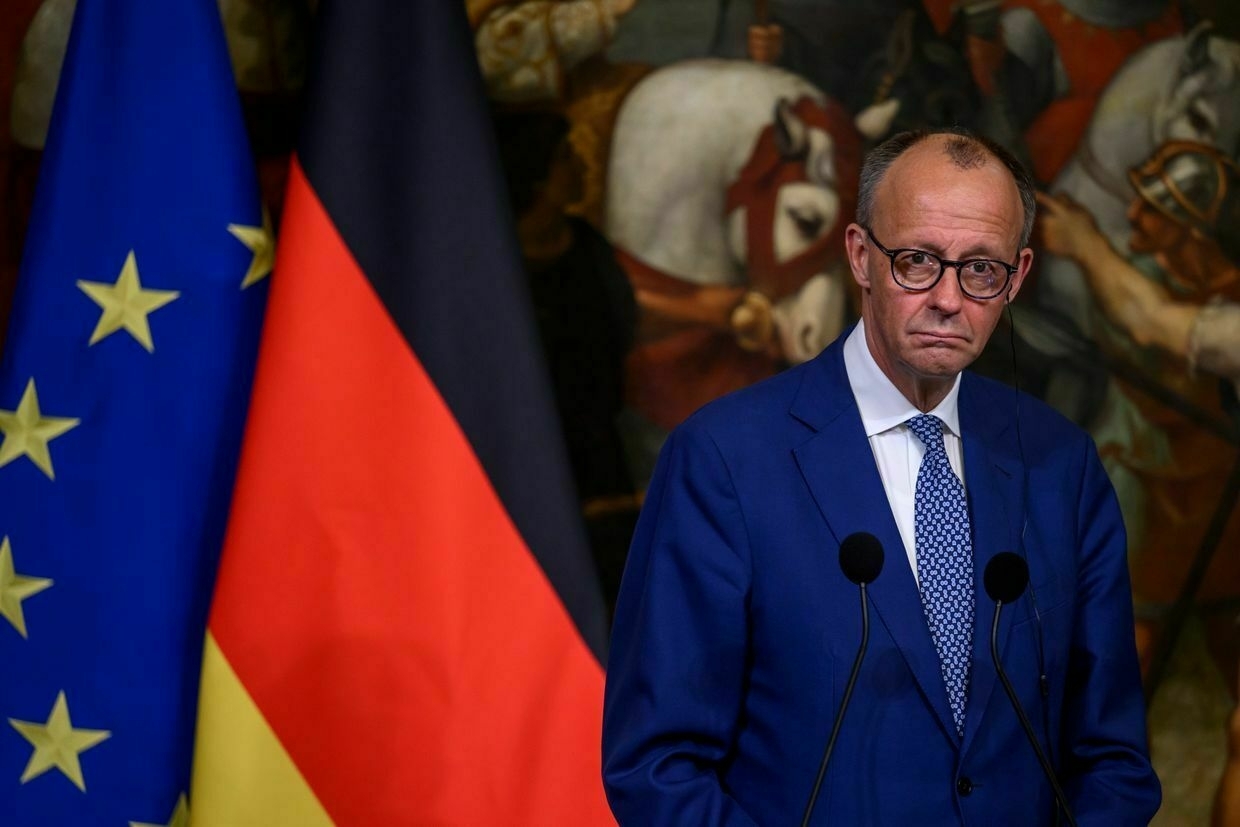
-
Author Yuri Andrukhovych on Ukrainian dissident art in Soviet times
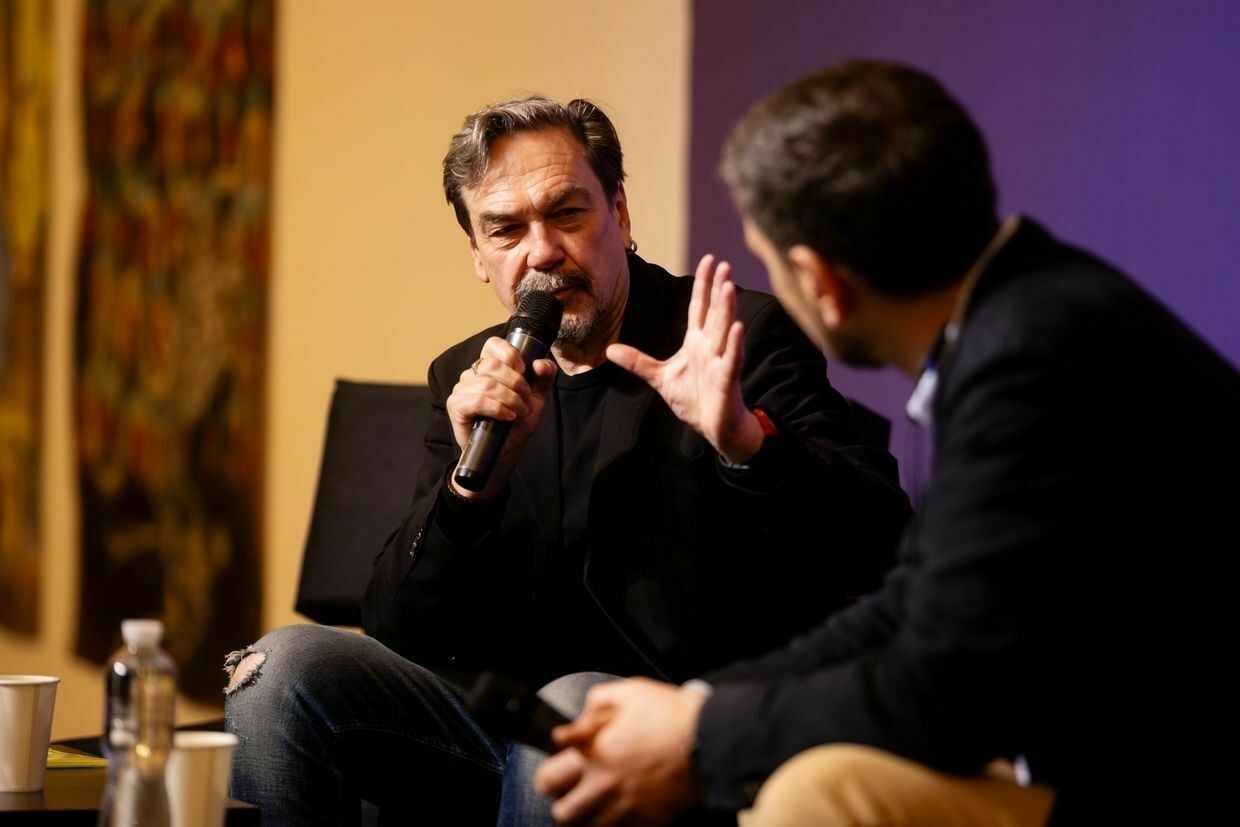
In Soviet times, being a pro-Ukrainian artist was dangerous. The Soviet secret police were particularly brutal in Ukraine, given that it was a country with a long history of resistance to Russian rule. Still, new generations of artists remained committed to their culture in the face of widespread Russification.
Among them was Yuri Andrukhovych, who, in 1985, co-founded the Bu-Ba-Bu literary performance group. Today, Andrukhovych is one of Ukraine’s most famous and celebrated authors. But his career started as part of a bold underground movement that quickly grew into a cultural phenomenon, signaling the country’s push toward independence. Bu-Ba-Bu’s rejection of censorship and societal taboos resonated deeply with the Ukrainian population, which was eager to embrace the ideals of creative expression.
In an interview with the Kyiv Independent, Andrukhovych opened up about the origins of Bu-Ba-Bu, the struggle of Ukrainian cultural movements in the face of Soviet censorship, and the profound sense of pride he feels as he witnesses Ukrainian culture thrive despite the adversity brought on by Russia’s war today.
This interview has been edited for length and clarity.
The Kyiv Independent: April marks a special month for the history of Ukrainian culture — it’s the 40-year anniversary of the founding of Bu-Ba-Bu. For our foreign audience, could you just tell us a little bit about what it was and your part in founding it?
Yuri Andrukhovych: Yes, it will be on April 17 — we have a precise date. I couldn’t participate in that very first meeting which took place in Lviv, though. It was a meeting between my two friends, the poets Viktor Neborak and Oleksandr Irvanets. I was supposed to join them, but I fell ill the day before. The year was 1985, and we didn’t know it yet, but it would turn out to be a very significant year in history.
Bu-Ba-Bu is, of course, an abbreviation of three different notions. The first “Bu” comes from “burlesque,” and the second from “buffoonery.” In between them is “Ba,” which comes from the word “balagan.” It is actually an old Hebrew world that means something akin to chaos or disorder.
Later, the term took on a special meaning, particularly in the cultural spaces of Eastern and Central Eastern Europe. “Balagan” came to describe a kind of small, wandering theater — a nomadic circus. It was a form of cheap, simple entertainment for ordinary people. Marketplaces in cities and towns across Central Europe often featured them.
We incorporated these three notions into our aesthetic program, but we never set out with a manifesto or a proclamation to change Ukrainian poetry or literature. We simply began by reading, writing, and sharing our poems — mostly with each other.
Ukraine’s longstanding aspirations for independence and freedom were seen (by the Soviet authorities) as the most dangerous tendencies in the former Soviet Union.
So, there were three of us, young and full of energy. I was the oldest in our trio at 25. My friends (Neborak and Irvanets) were both 24. With everything ahead of us, we set out to create our own kind of circus in poetry. We wrote poems that could be both a show and a performance. Our goal was to blend live performance with poetry that was deep, clever, and witty.
The Kyiv Independent: Could you talk about the public perception of your performances? Was there a hunger among the Ukrainian public for such poetry at the time?
Yuri Andrukhovych: Yes, everything came gradually, slowly. In 1985, there was still a difficult situation regarding censorship, with various obstacles imposed by the system to hinder artistic and literary initiatives. For the first two years (of Bu-Ba-Bu), our activities remained mostly private — built on friendships, personal connections, and informal gatherings.
Our first decision was to meet regularly. These meetings weren’t limited to Lviv, where Viktor Neborak lived then and still does today. We also gathered in Kyiv and Ivano-Frankivsk, the latter of which is my city. In many ways, our activities revolved around traveling and visiting one another.
Along the way, we organized small gatherings — let’s call them informal readings — held in intimate circles, often in artists' workshops or friends’ apartments. These gatherings usually included the three of us, along with five to seven others.
Our first real public performance took place in December 1987. By then, we had already existed for two and a half years before making our debut presentation in Kyiv. The venue was Molody Theater.
A significant change in its administration had just taken place. Sometime earlier, the theater had invited the renowned Ukrainian director and dissident Les Taniuk. After escaping the KGB in Soviet Ukraine, he spent several years in Moscow. Then, in 1987, he was invited back to Kyiv to take over as director and administrator of Molody Theater.
Les Taniuk was just brilliant. He completely reorganized the theater. He introduced an entirely new program. At the same time, he also launched several parallel initiatives. One of these was a series of literary readings. Our Bu-Ba-Bu event was actually the second in this series. The very first event was dedicated to the authors of the Executed Renaissance (a generation of artists that perished in the Stalinist purges in the 1930’s).
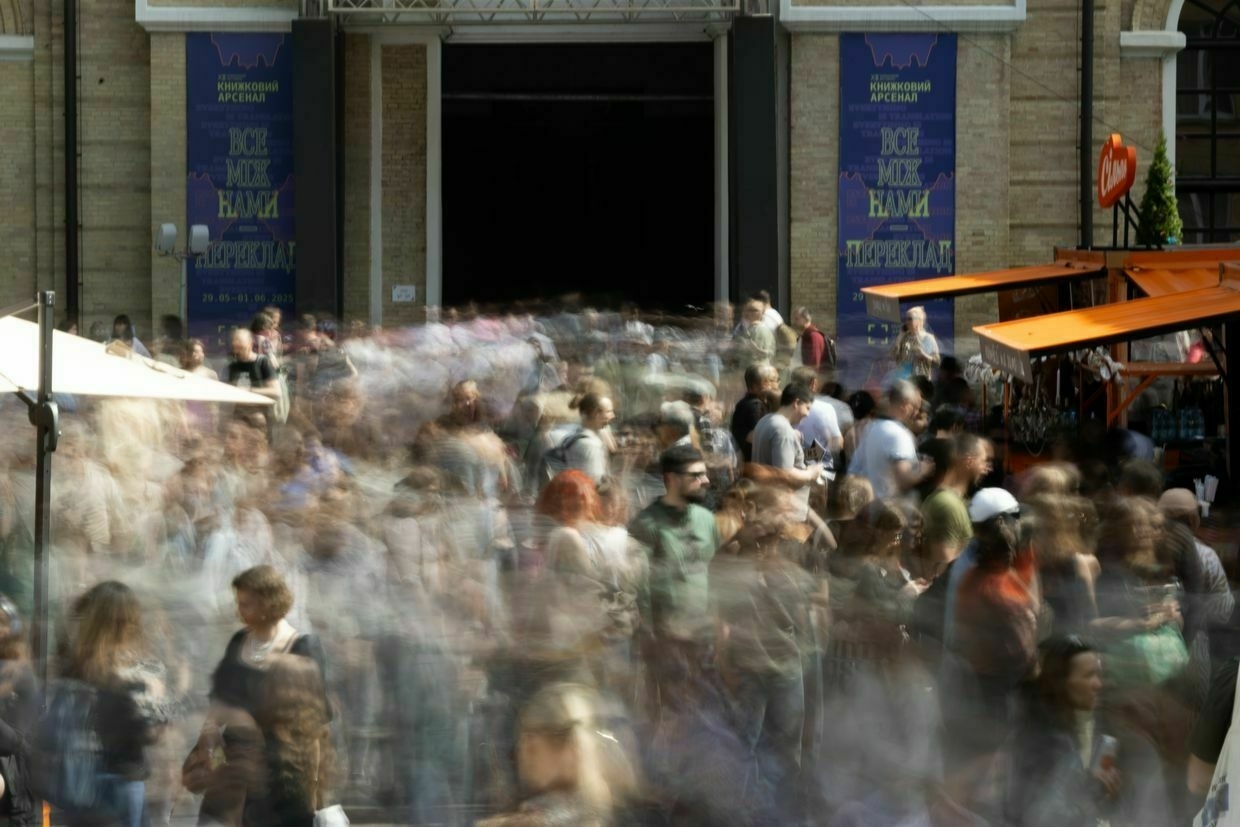
People attend the 13th International Book Arsenal Festival in Kyiv, Ukraine, on May 31, 2025. (Yevhenii Zavhorodnii / Global Images Ukraine via Getty Images) It was a bold and risky topic for that time. But it resonated deeply — people in Kyiv quickly realized there was a place where previously banned texts could be performed. A stage was open to anyone talented enough to bring something fresh and of high literary quality.
I look back on that evening with great happiness. It’s astonishing to remember a time without the internet or social networks. We had no advertising, nothing on TV or radio. At best, maybe a tiny mention, three or four sentences buried on the last page of a newspaper. Yet, word spread. Somehow, people found out. The space filled up completely. More and more people kept arriving, but there were no seats left. It was an incredibly promising start.
The Kyiv Independent: You mentioned censorship and how certain material was considered risky. Many foreigners tend to associate this with the earlier years of the Soviet Union — Stalin, the Great Purges. But can you talk about how, even in the later years of the Soviet Union, being a Ukrainian artist was still risky? What was it like to embrace the Ukrainian language and culture at a time when Russification was the norm?
Yuri Andrukhovych: When it comes to censorship in Ukraine, our Soviet Republic was a unique case. In the late Soviet period — the 1970s and 1980s, well after the Stalinist era — Ukraine still endured what felt like a softer version of Stalinism. In many ways, the situation here was much worse than in other parts of the Soviet Union.
There was more openness in the three Baltic republics, in Georgia, and, of course, in Moscow. Many Ukrainian artists and poets in the 1970s fled to Moscow, where it was less dangerous than staying in Ukraine. It was there they could escape the reach of the KGB, losing their trail in the vast sprawl of the city.
Ukraine’s longstanding aspirations for independence and freedom were seen (by the Soviet authorities) as the most dangerous tendencies in the former Soviet Union. The Ukrainian Republic was under very specific control.
The previous generations of Ukrainian poets, known collectively as the Sixtiers and the Seventiers, faced tremendous challenges.
Over the course of two nights (during the New Year's celebration), for example, the Ukrainian KGB launched a massive operation. Many people were arrested, and the Ukrainian cultural sphere faced continued severe attacks over the following weeks.
This led to numerous trials, and by the mid-80s, when our generation began, most of the people from 1972 — let's call them the "people of 1972" — were still political prisoners. They were either in labor camps or prisons. The most significant figure from that group was, of course, Vasyl Stus, who was killed in a Russian penal colony in September 1985.
Looking back, we can say with certainty that the situation in Ukraine at the time was a form of neo-Stalinism — a continuation of the same longstanding oppressive policies.
10 authors shaping contemporary Ukrainian literatureThe Kyiv Independent put together a list of 10 celebrated Ukrainian writers, some of whose works are available in English translation.The Kyiv IndependentKate Tsurkan
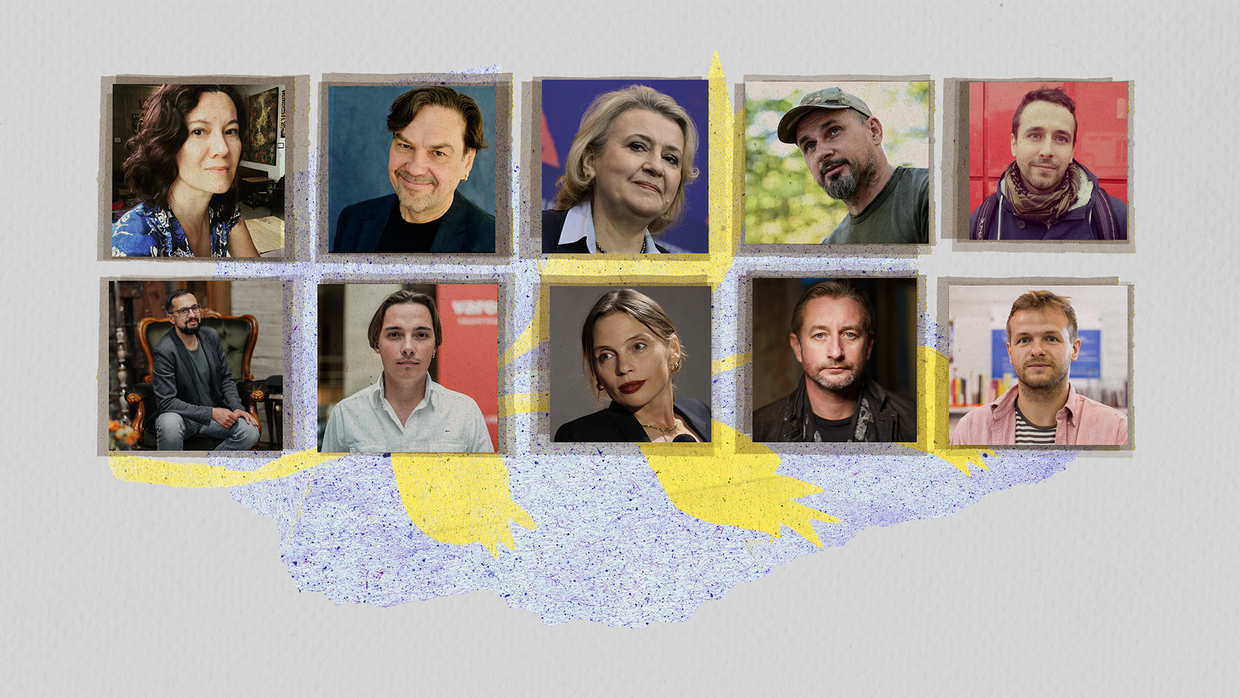
The Kyiv Independent: Since 2014, there has been much talk about a cultural renaissance in Ukraine. What is the most rewarding aspect for you about this comment moment in Ukrainian culture?
Yuri Andrukhovych: For me as a writer, the most significant changes have, of course, been in the publishing world and literary life. Since 2014, we've seen the rise of so many new publishing houses. There are also numerous new literary festivals and public readings. And, most importantly, we’ve witnessed a new wave of Ukrainian readers.
But it’s not just literature and publishing. There has been a rebirth of contemporary Ukrainian theater, and, of course, our visual arts have flourished as well. In fact, I’d argue that our visual arts were already unique and impressive even before 2014.
In my opinion, they represented a kind of avant-garde in contemporary Ukrainian art. These artists were creating brilliant projects using very modern forms of expression. They worked actively with installations and video art.
Before 2014, whenever I was in Europe, I would always find exhibitions or spaces showcasing new Ukrainian art. I felt incredibly proud to come from a country with such remarkable contemporary art. Since then, this diversity and richness have continued to thrive.
And, of course, we can’t overlook film and cinematography. I particularly see success in Ukrainian documentary films. But we also have feature films that are truly outstanding.
The most important thing is that people now want to experience this — attending theaters, paying to watch Ukrainian films, all of which is a very positive sign.

People attend the 13th International Book Arsenal Festival in Kyiv, Ukraine, on May 31, 2025. (Yevhenii Zavhorodnii / Global Images Ukraine via Getty Images) The Kyiv Independent: I’d like to conclude by discussing your poetry collection, “Set Change,” which was recently published by the New York Review of Books. This is a significant achievement, not only for you but also for Ukrainian literature in translation.
Could you talk about this collection? As I understand, it features poetry written early in your career, before you started to focus more on writing prose.
Yuri Andrukhovych: Yes, this collection consists of selected poems from my three first collections. The poems were written in the 1980s, and it also includes two cycles, “India” and “Letters from Ukraine.” It’s a mix of work I wrote from around 1980 to 1990.
This period represents the active stage of my poetic career. After 1990, I wrote more poems, but those were composed between 1999 and 2004. Some of the poems from that time, from my collection “Songs for a Dead Rooster,” had been published earlier in English translation by Lost Horse Press.
The idea for this new collection came from my American translators, Ostap Kin and John Hennessy. They suggested putting together the collection and I think they did an excellent job.
I was involved every step of the way, reviewing each batch of new translations. I paid close attention to each line, thinking carefully about how they had translated it. We had many interesting and productive discussions through our email exchanges — I’m looking forward to holding the hard copy in my hands.
Wondering where to start with Dostoevsky? Try his Ukrainian contemporaries insteadSince the start of Russia’s full-scale invasion of Ukraine in 2022, a growing debate has emerged over the cultural and political legacy of Russian literature — particularly the global reverence for classic Russian authors, which critics argue has long served to promote the imperial narratives embedded in their work. AsThe Kyiv IndependentKate Tsurkan
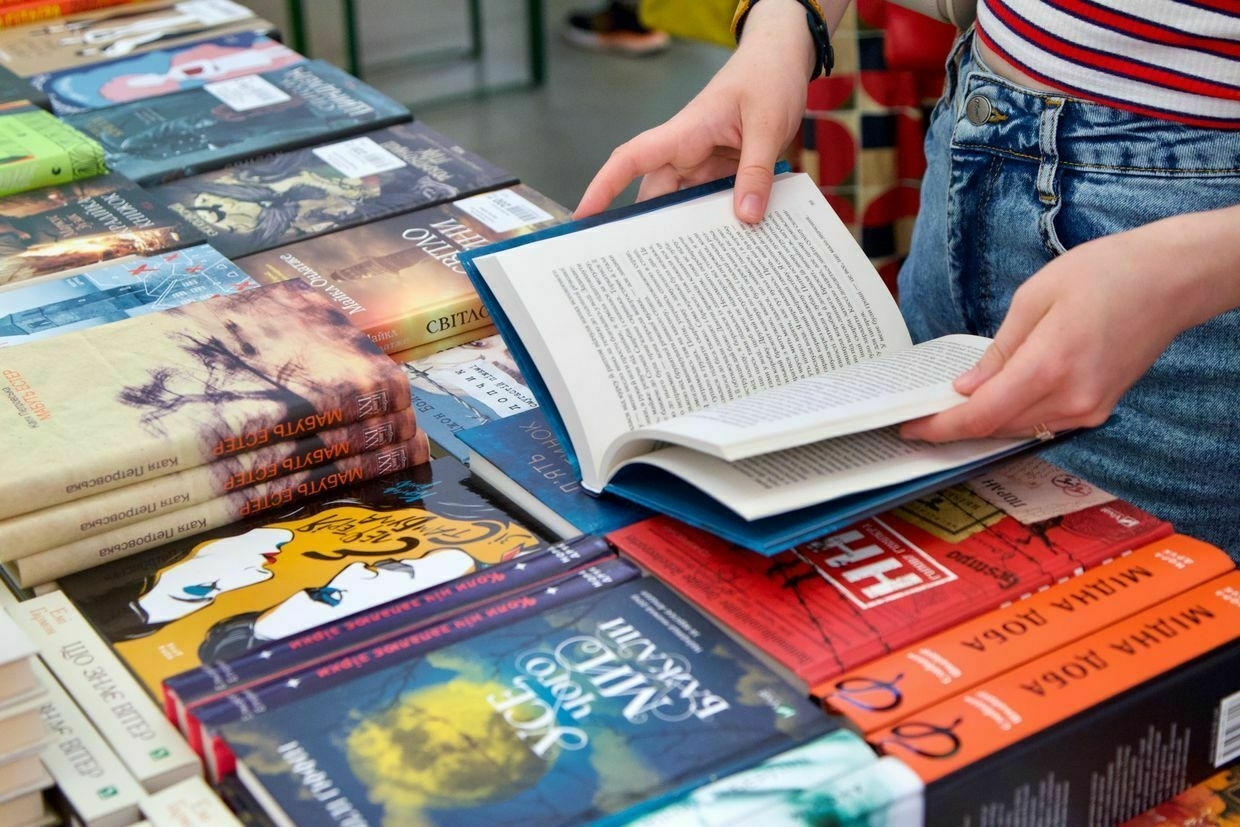
Note from the author:
Hey there, it's Kate Tsurkan, thanks for reading my latest interview. Yuri Andrukhovych is one of the greatest living voices in Ukrainian literature and this was my second time interviewing him. I hope more and more people across the world will learn about his work and his contributions not only to Ukraine but to world literature. If you like reading this sort of material, please consider supporting us by becoming a paid member of the Kyiv Independent today.
-
Transnistria again declares economic emergency over Russian gas cut

Moldova’s Russian-occupied Transnistria region declared a 30-day state of emergency in its economy on June 11, citing a sharp reduction in natural gas supplies, Moldovan media outlet Newsmaker reported.
The unrecognized region, located in eastern Moldova along the Ukrainian border, has faced growing energy shortages since January, when Russian gas giant Gazprom halted deliveries to the territory.
Transnistrian leader Vadim Krasnoselsky issued a decree unanimously approved by parliament. Lawmakers said the state of emergency was necessary due to a “severe general economic crisis” and ongoing socio-economic decline from the energy crunch.
It is the sixth consecutive extension of emergency measures in the region since December 2024. The most recent 90-day extension expired on June 8.
Transnistria had previously received around 2 million cubic meters of gas per day, but since early June, daily supplies have been halved, according to Moldovan energy official Alexander Slusar, cited by Newsmaker.
“This is a request from the company Tiraspoltransgaz (the largest gas supplier in Transnistria), which justifies its decision by citing a lack of funds,” Slusar said.
Chisinau has not been buying Russian gas since 2022, but Russian-occupied Transnistria continued to get its gas from Russia until Jan. 1, 2025. The halt in gas deliveries on Jan. 1 was due to Ukraine’s decision to stop Russian gas transit, including supplies to Moldova, and Moldova’s debt for gas supplies.
Transnistria had been effectively acquiring gas free of charge — a political tool that Russia used to keep the region under its control. The breakaway region’s debt for Russian gas amounts to more than $10 billion, according to Moldovagaz, a subsidiary of Russian gas giant Gazprom.
On Feb. 14, Transnistria began receiving gas through a new arrangement: fuel is delivered via a Hungarian company through Moldovagaz, the largest energy company in Moldova, with payments funded by a Russian loan.
The new arrangement followed extensive power outages in Transnistria, which drove the region toward industrial collapse.
In February, Moldova’s government said Transnistrian authorities rejected a 60 million euro ($62 million) EU energy aid package under pressure from Moscow, which continues to exert tight political and economic control over the region.
Transnistria, home to around 465,800 people, remains internationally recognized as part of Moldova but has been controlled by pro-Russian separatists since the early 1990s. Russia maintains a military presence in the territory, despite international calls to withdraw.
As Russia inches closer to Dnipropetrovsk Oblast, new Ukrainian region might soon be at warMoscow said its troops had crossed into Dnipropetrovsk Oblast and were conducting offensive operations in the region, a claim Kyiv quickly denied as “Russian disinformation.” Russian troops have been pushing toward Dnipropetrovsk Oblast for months, trying to solidify the southern flank to capture Pokrovsk and the remaining parts of theThe Kyiv IndependentAsami Terajima
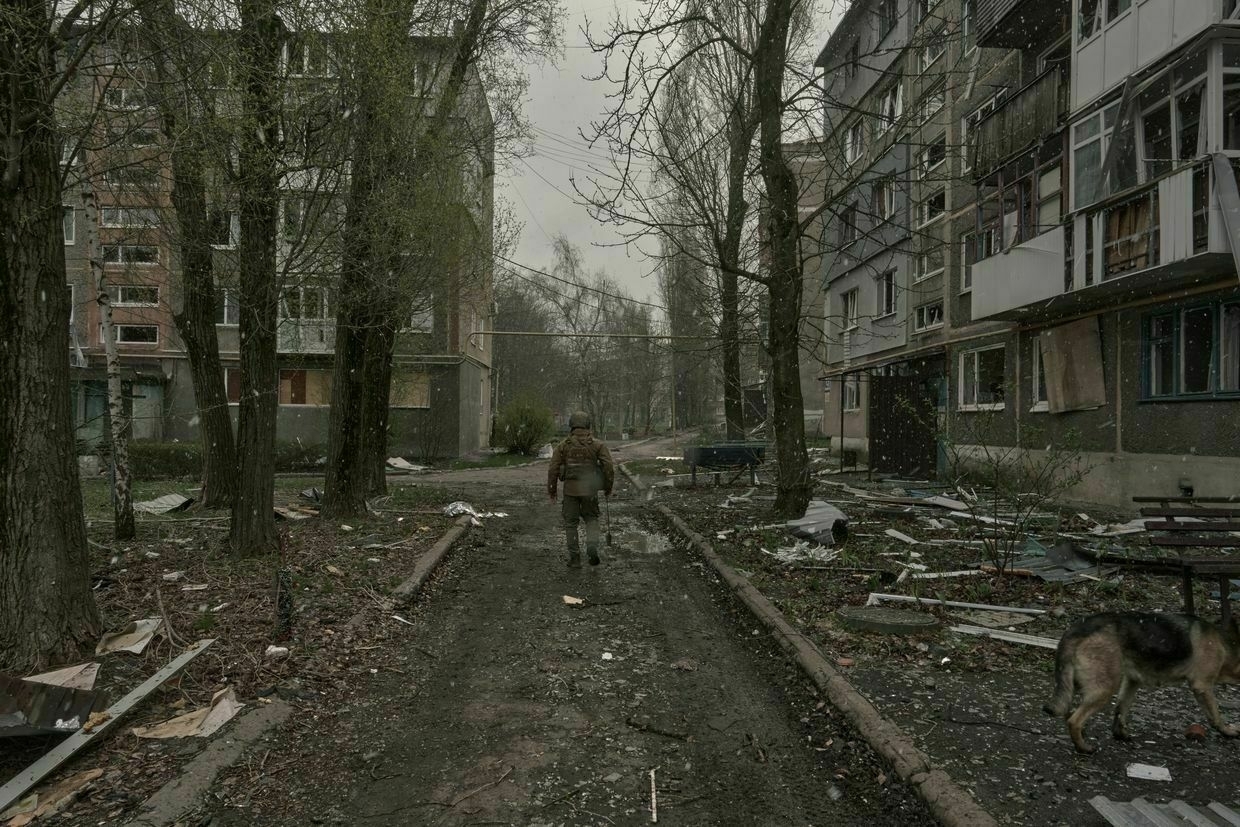
-
Russia has almost run out of tanks amid continued war in Ukraine
As 2025 unfolds, Russian tanks have effectively vanished as a battlefield factor. This isn't hyperbole but a reflection of harsh realities: Russian military vehicles capable of engaging in combat are either obliterated or beyond repair. The data from Warspotting indicated the lowest recorded losses of Russian tanks in May 2025 since the onset of the invasion not due to conservation efforts, but simply because they are no longer available. The age of Russian tank dominance has come to an end.
Charts delineate two distinct waves of tank losses. The first wave struck the regular Russian Army's battle machines, while the second involved military gear stored from the Soviet era. A third wave is unlikely—approximately 80% of storage facilities were depleted as early as 2024. Based on satellite reconnaissance and closer monitoring by Warspotting.net, an estimated 75% of all T-62 losses in 2025 were updates on the 2022 models, pulled from storage and revamped. Key point: the production line no longer rolls out new tanks but instead focuses on refurbishing metal remnants—a pace that critically fails to match frontline attrition.
The stark transformation is unmistakable: without adequate tanks, Russia increasingly relies on unarmored vehicles like jeeps, buggies, UAZs, and at times, motorcycles—light units that inevitably lead to increased personnel casualties. Infographic data show a gradual "dilution" of the tank fleet's structure, with the share of modern models (T-90, T-80) diminishing. T-62s, once mass-deployed, are now depleted. Occasional losses include the oldest T-55 models, affirming that any operable equipment is thrust into combat.
Analyses of T-72 series demonstrate that the most current models (T-72B3 variations from 2016, 2022, and 2025) no longer dominate the scene. Older iterations and experimental upgrades linger. As armored vehicle shortages mount, the Russian army suffers heavy infantry losses. Vehicles once serving as shields have vanished, regressing the army to infantry assaults devoid of support, akin to World War II tactics, but lacking numerical superiority.
Russia’s resources for a protracted armored warfare are depleted. The reserves of the self-titled "second army in the world" have proven finite, unsuitable for extended combat. Now, with even refurbished vehicles exhausted, the Russian army resorts to a "war on wheels" strategy, where armor scarcity renders any offensive a dangerous gamble on aged UAZ trucks.
-
What Russia's 1 million casualties mean for Ukraine
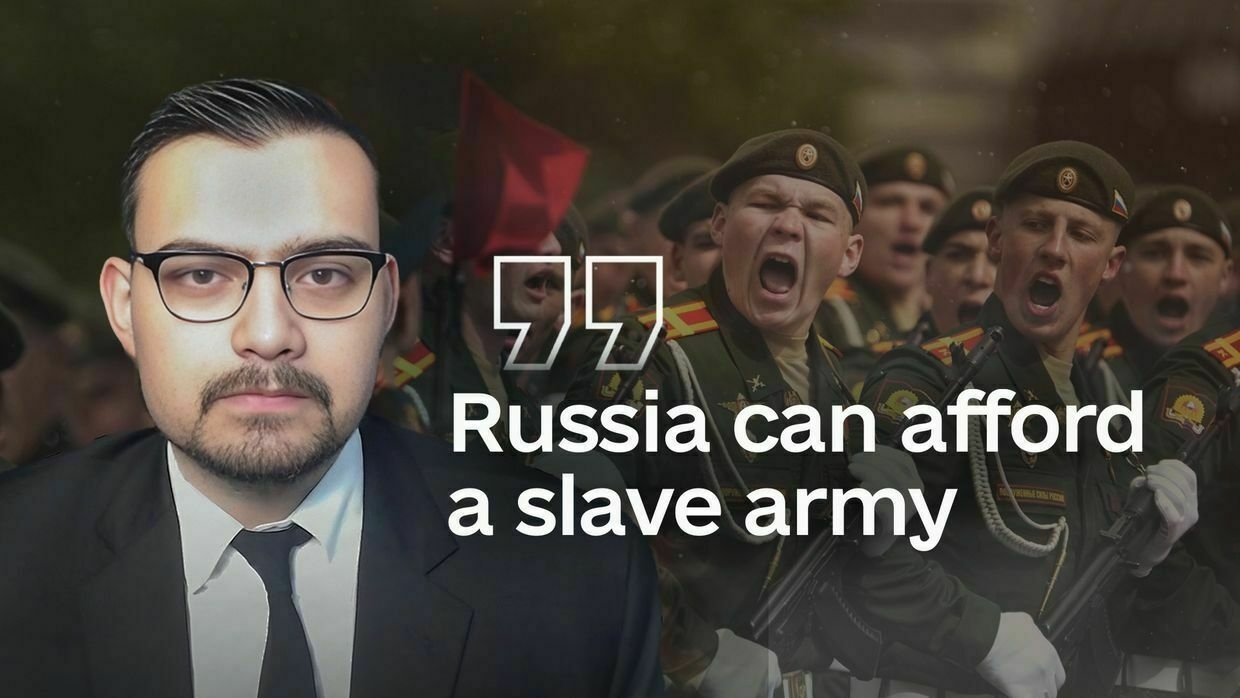
The Kyiv Independent’s Chris York sits down with George Barros, team lead for the Russia and Ukraine portfolio at the Institute for the Study of War, to discuss what Russia’s approaching one million casualties mean for its war effort in Ukraine. They explore how the Kremlin might generate more forces — and what impact this could have on Russia’s economy.
-
Ukraine to get $2.26 billion from UK for arms purchases, PM says
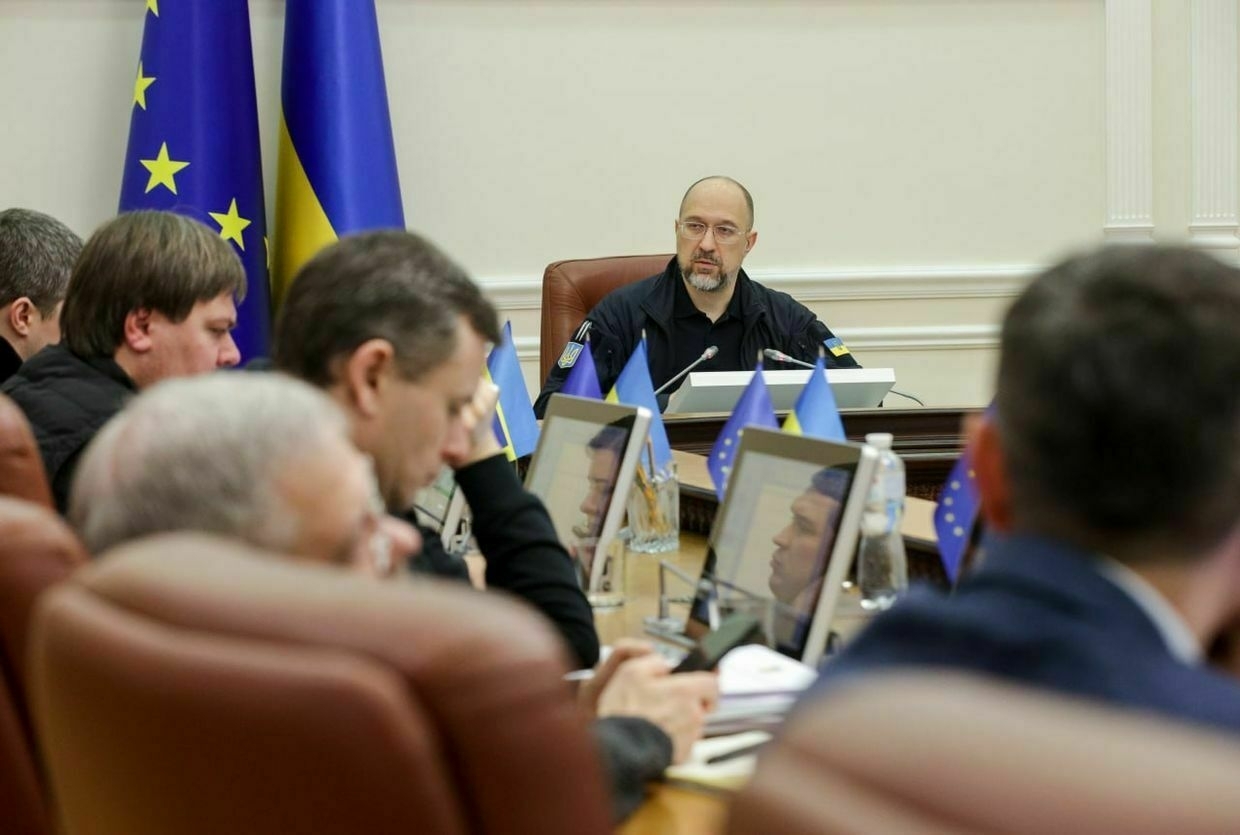
Ukraine is expected to get nearly 1.7 billion pounds ($2.26 billion) from the U.K. to buy air defense systems and missiles, Prime Minister Denys Shmyhal said on June 11, citng a decision by Ukraine’s Cabinet of Ministers.
The new funding will be used to buy Rapid Ranger air defense systems and Martlet lightweight multirole missiles, Shmyhal said, describing the deal as a “significant strengthening” of Ukraine’s air defense capacity amid intensifying Russian air assaults.
Rapid Ranger is a mobile, laser-guided air defense system built for rapid deployment and effective against low-flying threats, including drones and helicopters. It is typically paired with the Martlet missile, which is designed for use against drones and light aircraft.
“This month, the U.K. also announced record aid for the supply of drones. We are talking about 350 million pounds ($473 million), which will allow 100,000 drones to be transferred to Ukraine this year,” Shmyhal wrote on Telegram.
The announcement follows Russia’s June 10 aerial attack on Kyiv, one of the largest during the full-scale war. The night before, Ukrainian air defense shot down 479 Russian drones and missiles in a record air assault, according to the country’s Air Force.
This year, the U.K. has allocated 4.5 billion pounds ($5.8 billion) for military assistance to Ukraine, marking its largest annual commitment so far.
London remains one of Kyiv’s most steadfast military partners, providing long-range missiles, armored vehicles, training, and political support against Russian aggression.
Russia’s nuclear deterrent against US not ‘significantly’ affected by Ukraine’s Operation Spiderweb, official claims“Our nuclear deterrence potential against the U.S. and any other potential adversary has not suffered significant damage,” Russia’s Deputy Foreign Minister Sergei Ryabkov said.The Kyiv IndependentAnna Fratsyvir
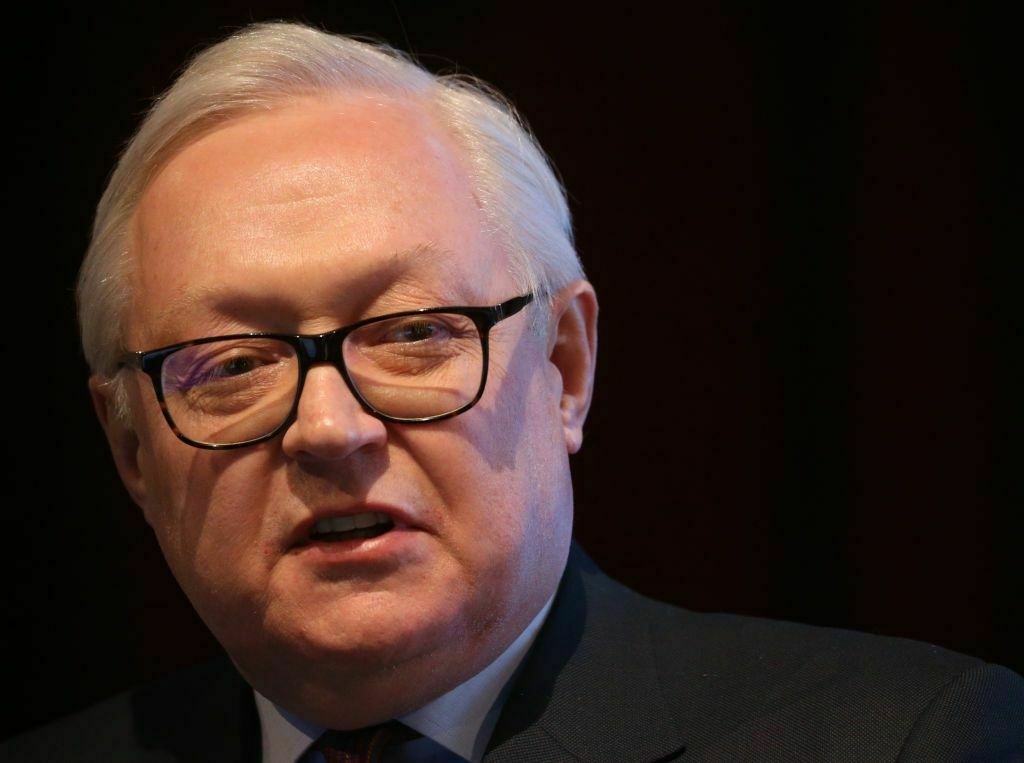
-
Exchange of strikes! Russia terrorizes civilians, while Ukraine destroys military factories
-
Russian drone strikes hit Kharkiv: 64 injured, 3 killed
Russian forces launched a drone attack on residential areas in Kharkiv on June 11. The latest reports confirm that 64 people have been injured, with nine of them being children.
Ukrainian President Volodymyr Zelensky said that recovery efforts are ongoing in Kharkiv following the nighttime assault by Russian "Shahed" drones. The strikes targeted ordinary residential buildings. Tragically, three fatalities have been confirmed so far.
"Every new day now brings fresh malicious strikes from Russia, and nearly every attack is demonstrative. With each blow to ordinary life, Russia underscores that existing pressure is insufficient. There is a need for bold actions and new decisions that can create difficulties for Russia. Without this, they will not engage in genuine diplomacy. The United States and other global leaders have a significant role in this. Anyone advocating for a cessation of the violence and a diplomatic solution must take action," the President emphasized.
In Kharkiv, Russia deployed drones, sparking fires across two districts. Mayor Ihor Terekhov reported that the strikes hit a five-story residential building, igniting fires in 15 apartments. According to the Situation Center, Russian forces launched 17 drone attacks on the city. Additionally, the Russian military targeted the Odesa region. Overnight, social media reports mentioned hearing "Shahed" drones and anti-air defenses at work in the region. The State Emergency Service of Ukraine confirmed nighttime attacks on the Odesa region by Russian forces. These strikes led to the destruction and damage of summer homes, utilities, vehicles, and civilian watercraft. Fires broke out, which rescuers have since extinguished.
-
How Holodomor famine still scars Ukraine food habits
Editor’s note: June has historically been our toughest month, where we see a lot of unsubscribes.
Amid the constant attacks in Ukraine, we need your help: will you upgrade to a paid subscription to support our original work now?
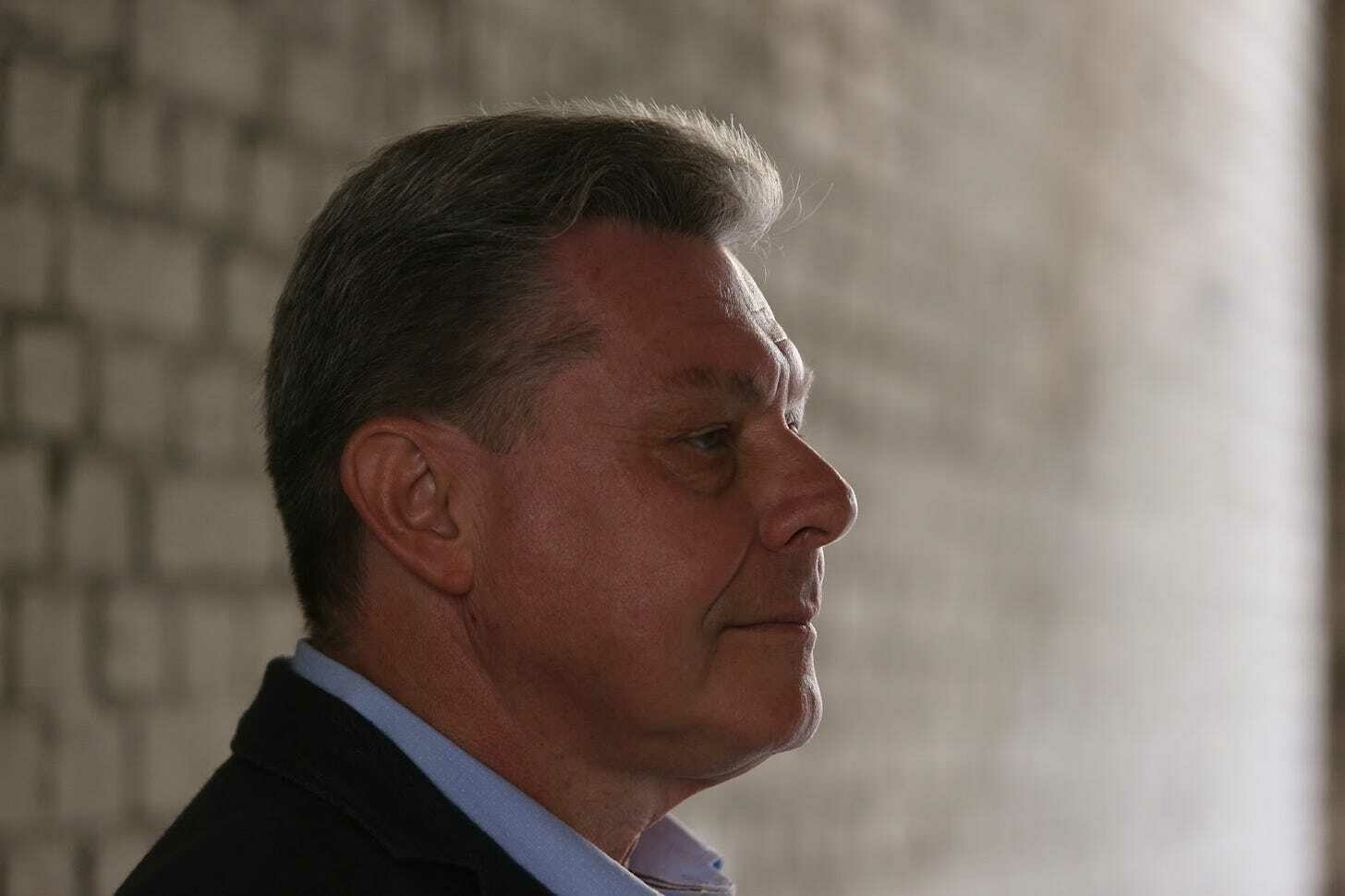
Oles Ilchenko, whose family survived Holodomor 1932-1933. (Photo provided by Oles to The Counteroffensive). “Instinctively, I catch myself on what I've been taught since childhood: that I have to eat up,” said Oles Ilchenko, a Ukrainian writer. “Sometimes I consciously stop.”
The rule of leaving no crumbs after a meal is still engraved in the subconscious of many Ukrainians. It’s just one of the scars still showing after a man-made mass famine in the Soviet Union in early 1930s killed about four million people.
More than 90 years later, the Holodomor remains deeply ingrained in the daily lives of Ukrainians and their meals. The instinct to never waste food – and the quiet joy of a well-stocked pantry – are traditions passed down through generations, as the trauma of starvation lingers in collective memory.
In Ukraine, preserving and rationing food has become a way of life, shaped by the legacy of the Holodomor. The canning and bottling of preserved food in basements was a critical reason why so many Ukrainians survive periods of occupation in the ongoing war.
And the tool of hunger as a weapon of oppression echoes today, as Russia’s military continues to starve Ukrainian prisoners of war.
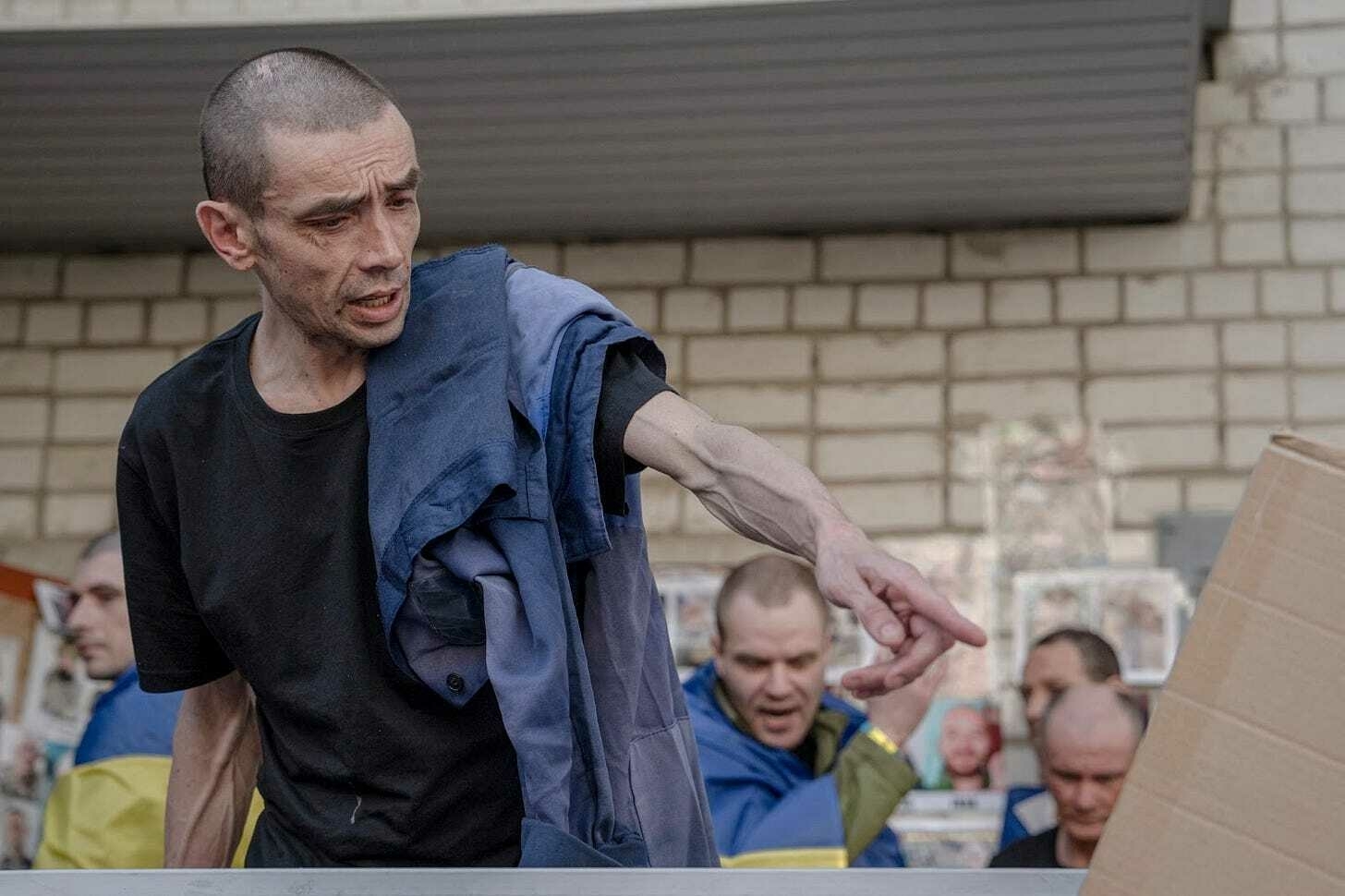
A POW gestures toward portraits of missing or captured servicemen, during the arrival of freed Ukrainian POWs after a prisoner exchange on June 10, 2025. (Photo by ANDREW KRAVCHENKO/AFP via Getty Images). Oles Ilchenko, 67 years old, is a Ukrainian writer, artist, and teacher at the first Ukrainian school in Geneva, Switzerland. He was born in Kyiv and spent most of his life there.
As a young teenager living in Ukraine, he would hear his family tell vivid stories about their experience during the Holodomor. His mother was reluctant to share, but his grandmother was an open book. Oles’ family lived in Ukraine’s central village of Kerelivka (Shevchenkove), in the Cherkasy region, during the Holodomor.
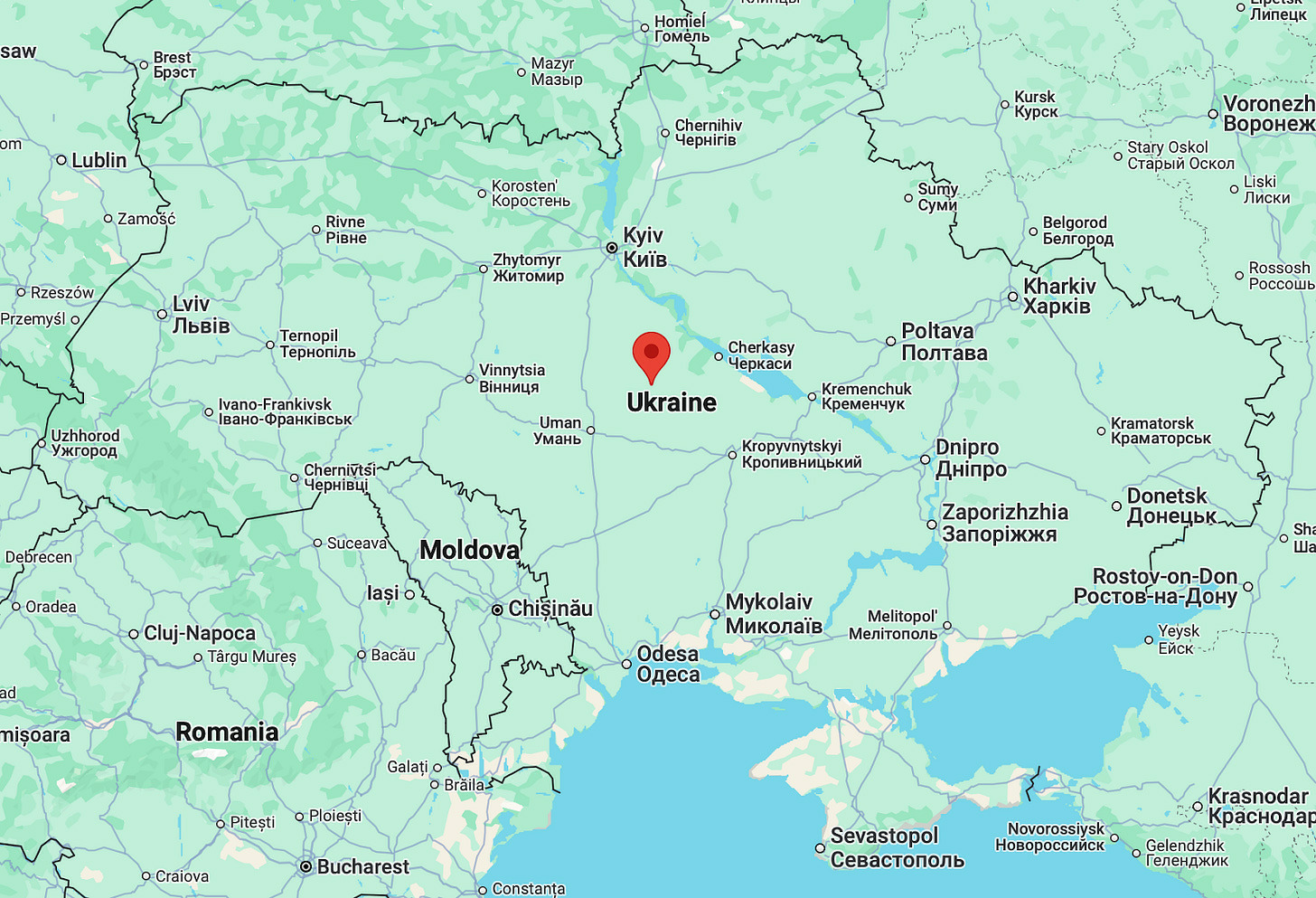
The village of Kerelivka (Shevchenkove), Cherkasy region, where Oles’ relatives lived during the Holodomor. (Screenshot from Google Maps). Oles moved to Switzerland in 2011 due to his wife’s job. Although he’s been away from Ukraine for 14 years, the experiences of his relatives still haunts him.
“I still can't watch them [Europeans] in a restaurant or a cafe, getting up, dropping everything – taking a bite of some cake, not liking it – because they didn’t want to eat it,” he said. “It still somehow doesn't leave me indifferent.”
Now, he tries to stop himself every time the old habits kick in, which can include overeating or feeling guilty over wasting food.
Oles has done everything he could to avoid passing on these traumatic habits to his now 35-year-old son. He claims to have never forced him to finish his meals, which is something his parents would make him do:
“Finish it all, don't leave it, you can't throw it away,” Oles recalled his relatives telling him when he was young. The forced feeding – often an unhappy memory in and of itself, was a reflection of a mentality that it is better to eat now because there may be no food tomorrow.
“[Even when] the child doesn't want to eat anymore, [he was forced] to eat.”
Even today, Ukrainian prisoners of war are tortured with starvation by Russian forces, violating all the norms outlined in Article 26 of the Geneva convention – a chilling echo of the same weapon once used by the Soviets. Many soldiers return exhausted not only from the physical torture they endure, but also from the lack of proper nutrients they receive.
Foreigners visiting Ukraine have been surprised by Ukrainians’ relationship with food.
“One of the things that struck me the most was how people don't waste food, like no one will throw bread away, particularly bread,” said Felicity Spector, a British journalist and author of the book ‘Bread and War’.
For Ukrainians, bread is sacred. It is ‘vsomu holova’ (‘head of everything’), ‘sviatyi’ (‘holy’) and ‘Bozhyi dar’ (‘God’s gift’).
During the famine and the years that followed, when there was nothing sweet to eat, Ukrainians would make bread with butter or honey on top, or simply wet a slice of bread with sugar. If bread becomes stale, it can be made into croutons that can be added to a soup or salad.
Before the Soviet Union, traditional Ukrainian bread was made of sourdough and grain.
The Holodomor was a man-made famine in Soviet Ukraine, caused by Stalin’s policies to suppress anything un-Soviet, targeted Ukrainian farmers through forced collectivization and grain seizures. Millions died in 1932-1933, and the famine is now widely recognized as a delibarate act of genocide intended to break Ukrainian resistance and identity.
On August 7, 1932, the so-called 'Law of Five Ears of Grain’ was adopted, which stated that ‘stealing’ common property, which could even mean picking up grain from the ground, could lead to confiscation of property or even execution.
Amid the new law, people could no longer cook or buy grain bread, as there was a lack of ingredients. Innovative cooks made bread out of peas, corn, acorn shells, or potato scraps.
Oles remembers how the imitation bread of the 60s, bought from the store, “tasted very bad and it was falling apart.”
Even years after the Holodomor ended, bread shortages persisted due the failure of collective farms. Oles’ father once went on a business trip to Leningrad, now known as St. Petersburg, and brought back two highly-coveted loaves of bread as a gift.
“And I remembered those two loaves so much, how we didn't know how to eat them or what to do with them,” Oles said. “And it was 1963, 30 years after the Holodomor. But the memories were so fresh, and everyone was really afraid that it would happen again.”
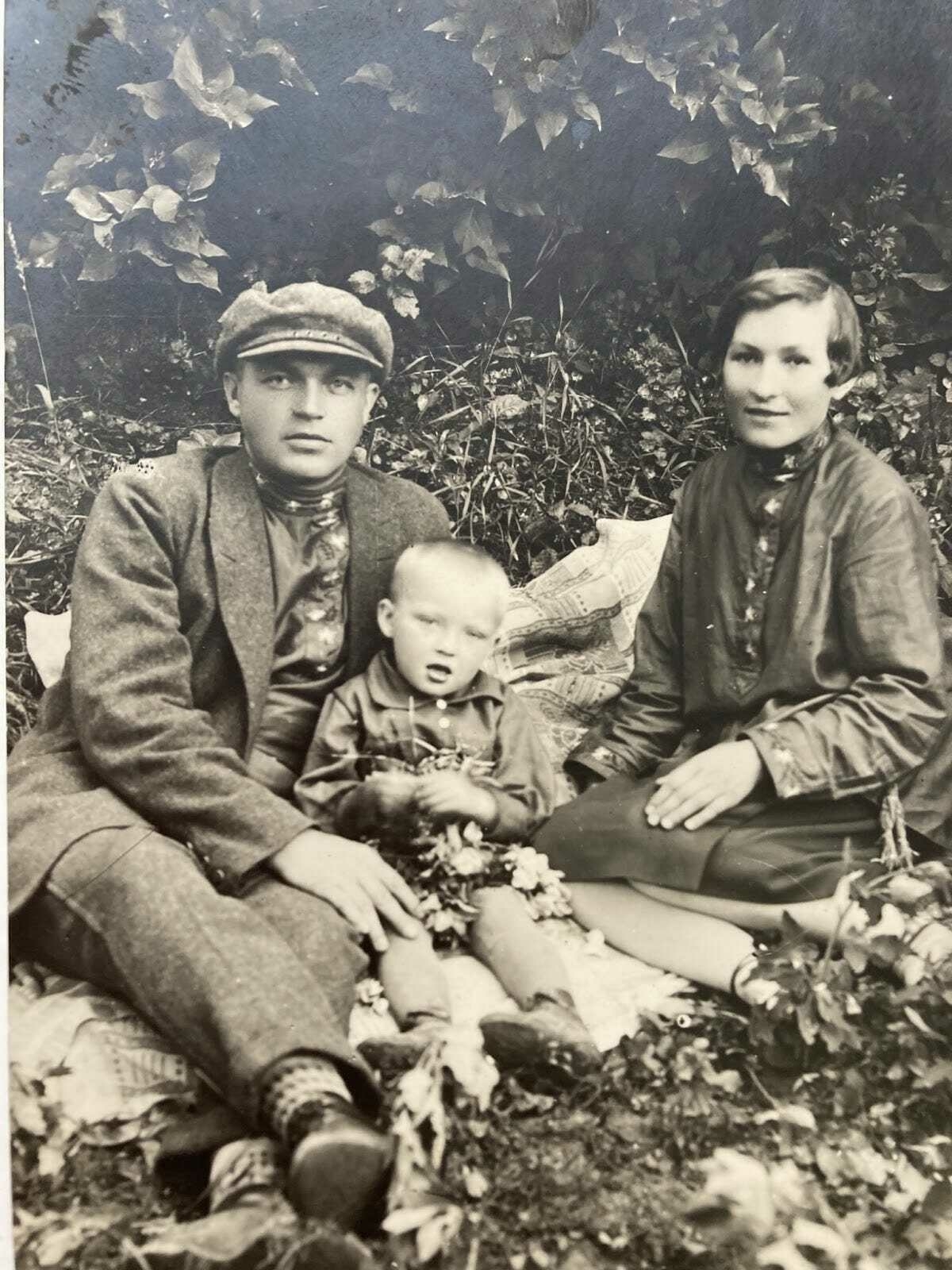
Oles’ grandfather, Zakhar Ilchenko, his grandmother, Mariia Kovalenko, and his mother, Diana Ilchenko, before the Holodomor. (Photo provided by Oles Ilchenko). For grandparents triggered by the horrors of famine, kids are never full.
“Grandparents look and see how thin he [a child] is, ‘we need to feed him more’,” said Vitalii Klymchuk, a Ukrainian therapist and Director at Mental Health. Even doctors sometimes tend to comment on a child’s weight, he said.
During phone calls, the first question from grandparents is usually: “Have you eaten?” or “Are you hungry?” These small details can be traced back to the time when feeding a child meant keeping them alive.
When the Holodomor started, Oles’ grandmother, Mariia Kovalenko, was a young mother. People ate whatever they could find or hide.
“My grandmother told me that they hid a bag of dried cherries in the attic and ate them secretly at night,” Oles said. “And that's how they survived.”
In the 1920s, a grain procurement crisis arose when farmers refused to sell grain at a discounted price to the USSR. Amid the crisis, Soviet leaders imposed the collectivization of the agricultural sector in 1929, forcing people to enroll in ‘kolkhoz’ – collective farms. The policy was aimed at wealthy peasants who disagreed with the grain prices – 113,000 of them were later deported.
Approximately 70 percent of peasant farms were collectivized – roughly half of the population of Ukraine at the time. The Soviet leadership thought the initiative would increase the food supply. But by beginning of 1932, every farmer was experiencing hunger.
“It was insanity, cannibalism, and degradation when they [people during Holodomor] ate roots, leaves, and bark,” Oles said. “This is simply reducing a human being to the level of an animal that only thinks about what to eat, and cannot think of anything else.”
There were more than 2,000 criminal cases of cannibalism during 1932-1933, according to Mykhailo Kostiv, Head of the Department for the Study of Genocide, Crimes Against Humanity and War Crimes.
Oles was shocked by a story his grandfather told. Perhaps it was a rumor, perhaps it was true. But it showed the sort of lives these people lived: A woman became so desperate that she killed a child and boiled it. She was shot on the spot by authorities.
Such horrors transformed food from a mere substance to something to be coveted and preserved. Ukrainians have long found ways to reuse spoiled food instead of discarding it. If milk starts to sour, for example, they can make other dairy products, such as kefir (a thin yoghurt) and cheese.
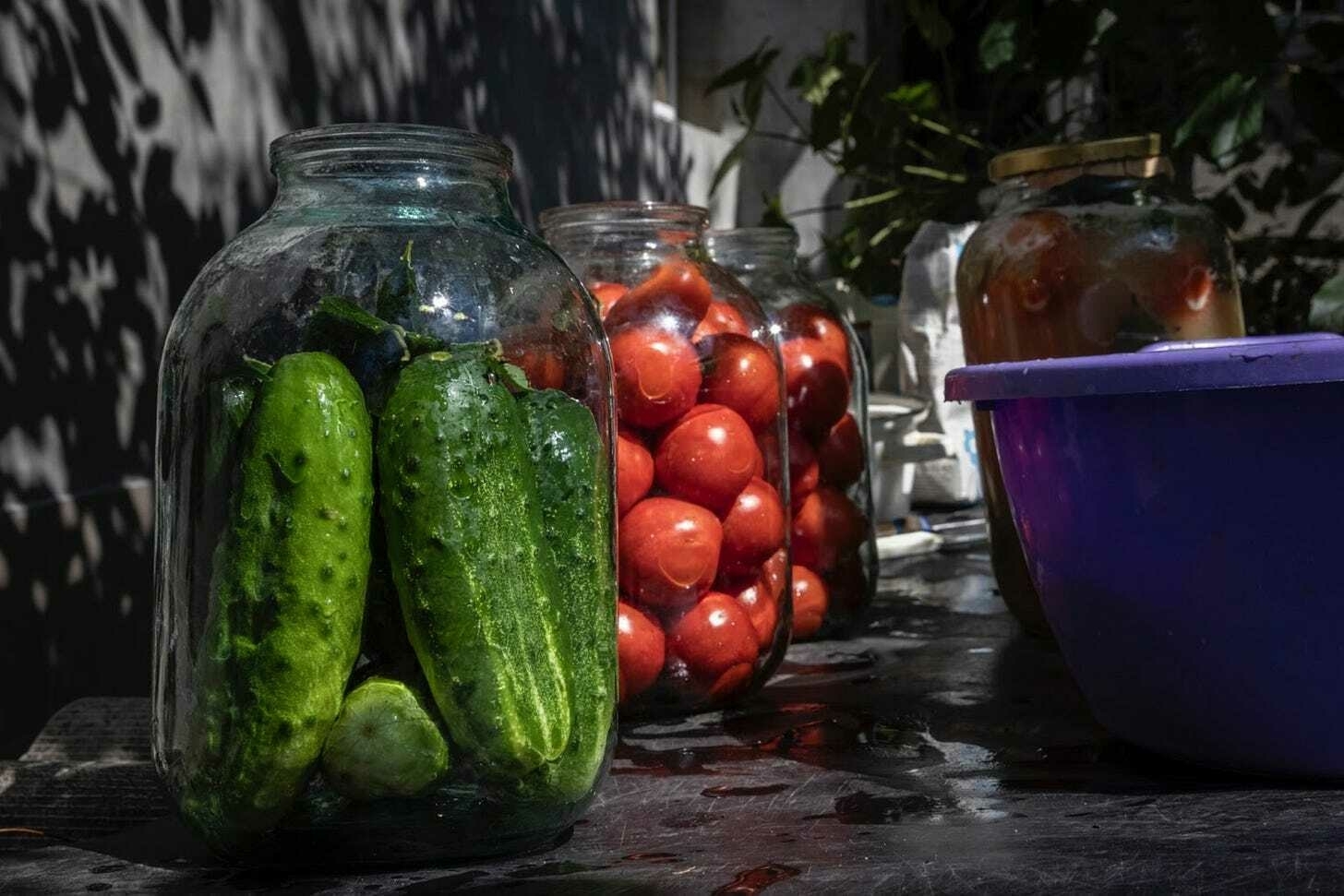
Traditional Ukrainian pickling season starts in mid summer as fruit and vegetables grow ripe in mineral rich soil and the home-grown produce is harvested and preserved in large jars. (Photo by Ed Ram/Getty Images). “It becomes clear why all families, Ukrainian ones, had such fantastic winter preparations,” Oles said, adding that they all kept jars of pickles, fermented foods, jam, and jelly in storage. “And these jars were in incredible numbers, you couldn't eat them all.”
Oles’ grandmother even stored jars filled with every “imaginable and unimaginable” type of fruit for years. Nowadays, even with access to supermarkets, Ukrainians continue to store food this way. The majority of Ukrainians living in villages, in houses with cellars, use this method to prepare for winter.
A Ukrainian family that Oles knows, who has lived in Geneva for the past 20 years, also stores food in preparation for winter.
Dried cherries are one of the reasons why Oles’ family survived during the Holodomor — a habit many Ukrainians have continued to use since. They gather vegetables and plants during the spring and summer, and freeze or dry them to store for the winter.
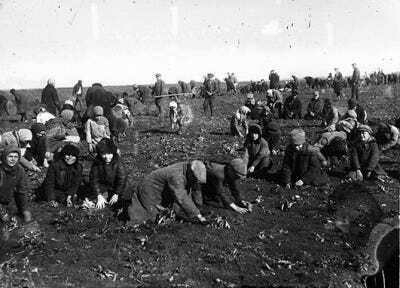
Children picking frozen potatoes on a collective farm field in the village of Udachne, Donetsk region, 1933. (Source: ЦДКФФА України імені Г. С. Пшеничного). Ukraine harvests approximately 18 tons of potatoes annually, with only two percent of these being produced by commercial and private enterprises. One-third of it is stored in the cellars of Ukrainians, and often goes uneaten for years.
During the winter months of the Holodomor, children would gather potatoes, both frozen and rotten, that were left over from the harvest, and their families would cook surrogate food – food substitutes made from non-traditional or inedible ingredients – with them. For example, traditional pancakes were made of potato starch or peels.
“I remember this old tradition of my grandmother and her two brothers, when other people would come – I was just amazed at how much food they cooked,” Oles said. “There were mostly borscht, sometimes soup, always two meat dishes, salads, and at least two cakes.”
At a certain point, amid the food shortages, Ukrainians began to prioritize the nutritional value of each meal. In 1939, the book ‘On Tasty and Healthy Food’ was published. The purpose was to educate people about the nutritional value of products, its calorie content, and cost.
As a result, Soviet dishes, such as Olivier and crab salad, began to gain popularity. The salads contained boiled eggs, potatoes, vegetables, rice, mayonnaise, and sausages — cheaper and of lower quality than meat.
Even 90 years later, some descendants of Holodomor survivors are developing eating disorders amid the fears and misconceptions imposed on them.
Other Ukrainians with ancestors who survived the famine have a higher risk of developing type 2 diabetes. Examining more than 10 million Ukrainians born in the 1930s, a scientific study found that exposure to famine during early childhood more than doubled the chances for developing type 2 diabetes in later life.
To this day, some people still struggle to discuss the famine.
“I know that in many families they did not want to or did not like to remember these events,” Oles said. “My mother did not like it either. But my grandmother did not hide it.”
It takes a great deal of self-reflection to see how context becomes character.
But for every preserved jar still sitting in dark Ukrainian cellars, for every piece of stale bread carefully repurposed for later, is a story of survival.
NEWS OF THE DAY:
Good morning to readers; Kyiv remains in Ukrainian hands.
U.S. MAY SEND UKRAINIANS TO GITMO: This week, the U.S. may begin relocating thousands of foreigners who are staying in the country illegally, The Washington Post reported.
They will likely be sent to the U.S. military base in Guantanamo, Cuba. Among them are citizens of allied countries such as Ukraine, the U.K., Italy, France, Germany and Belgium
The Trump administration is unlikely to inform the allied governments before this sort of forced relocation. Guantanamo Bay is known as a prison for terrorism suspects and others captured after the events of 9/11. In January, Trump stated that he would move up to 30,000 migrants there.
‘OPERATION SPIDER WEB’ CARRIED OUT WITH UNIQUE DRONES: SBU engineers developed unique drones specifically for ‘Operation Spiderweb,’ Babel reported. Operators could remotely control the drones in real time from thousands of kilometers away from Ukraine’s state border, as well as bypass Russian air defense systems.
According to SBU claims, these drones were able to strike approximately 34% of Russia’s strategic aviation, thereby weakening Russia’s capacity to deliver massive strikes on Ukrainian cities.
RUSSIAN SPY DETAINED IN POLAND: A Polish citizen has been arrested on suspicion of spying for Russia, the Polish prosecutor’s office reported.
He had been transmitting information to Russian intelligence services from February 2024 to April 2025. This included data on infrastructure critical to Poland’s defense. The disclosure of this information allegedly posed a serious threat to the country’s national security.
This is not the first time Russian spies have been exposed in Poland. They have reportedly been carrying out sabotage attacks on Polish territory, directed by Minsk and Moscow.
DRAKONCHIK OF WAR:
Today we have a drakonchik of war (a diminutive of ‘dragon’ in Ukrainian) from our reader Anna Bowles!
Whenever she comes to Ukraine, he sits on the windowsill, ready to spit fire at any drones or missiles that might dare to approach the building.
Stay safe out there.
Best,
Tim



